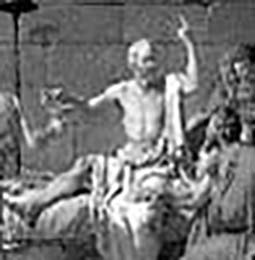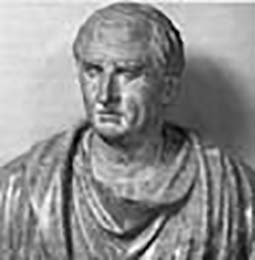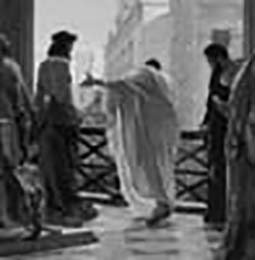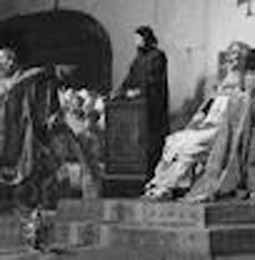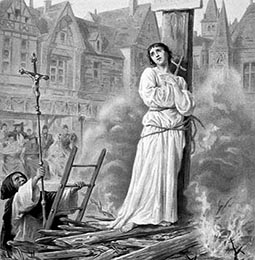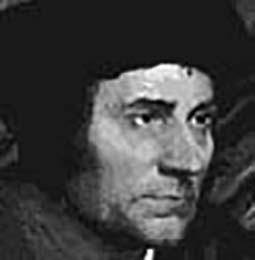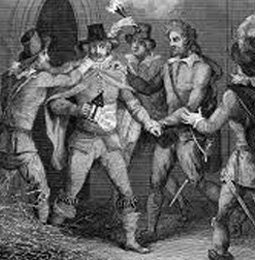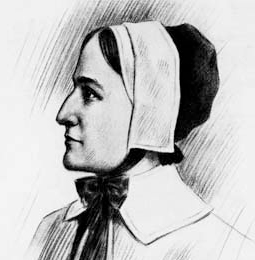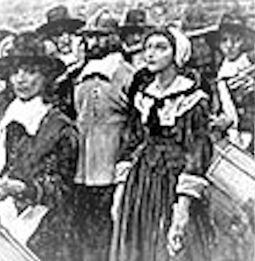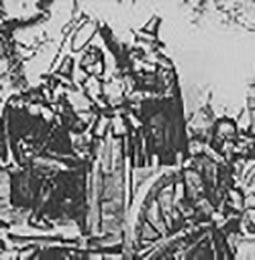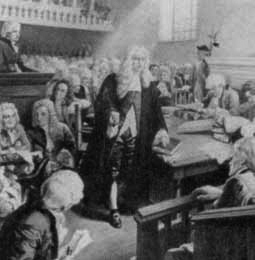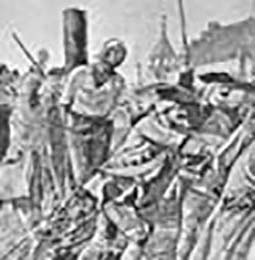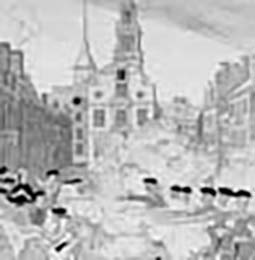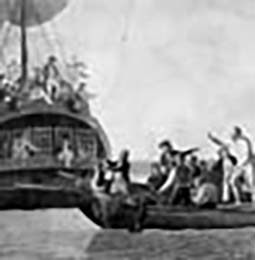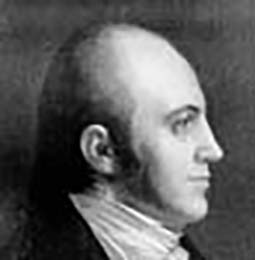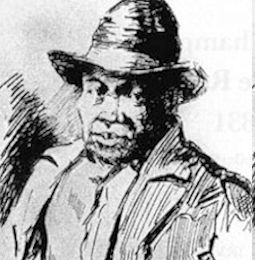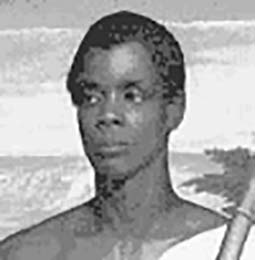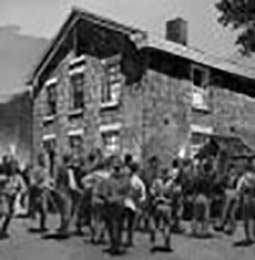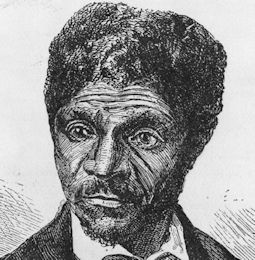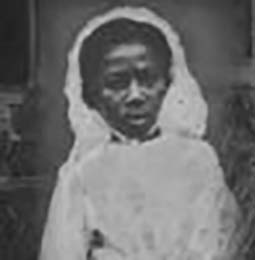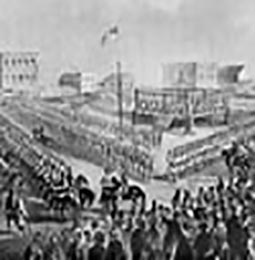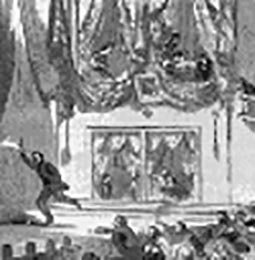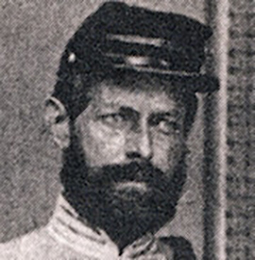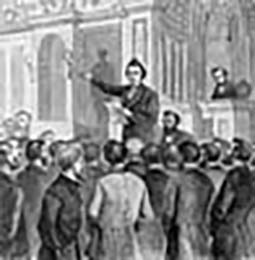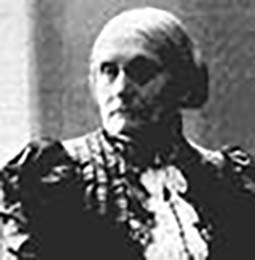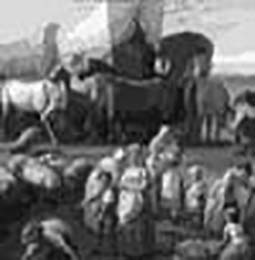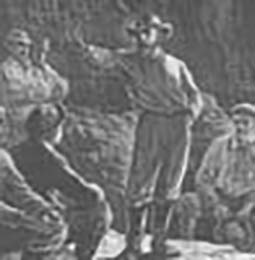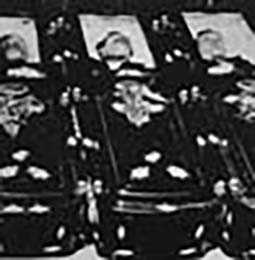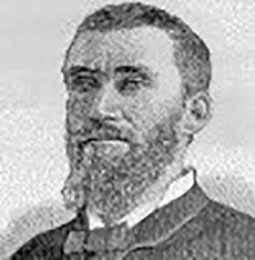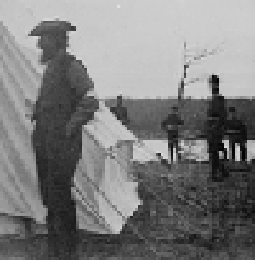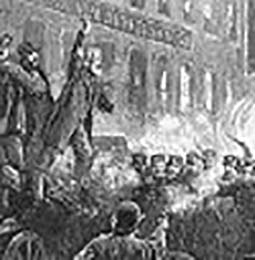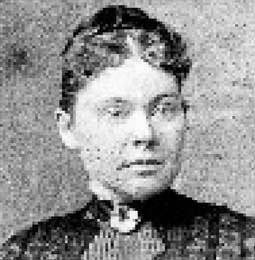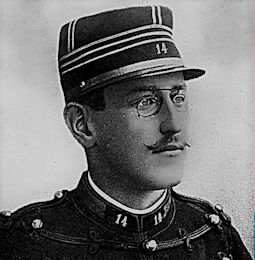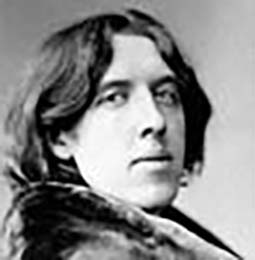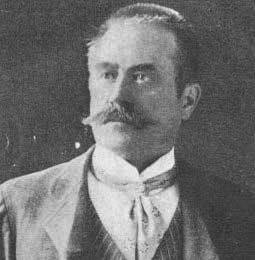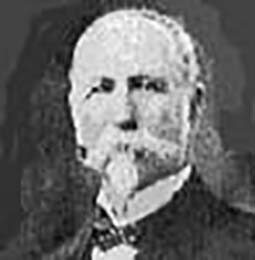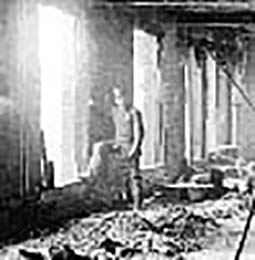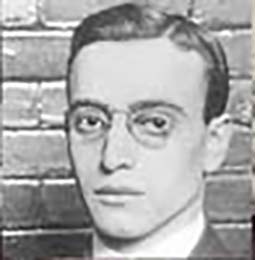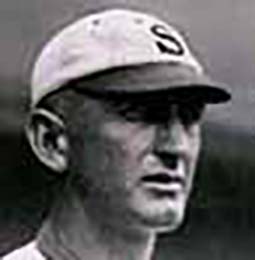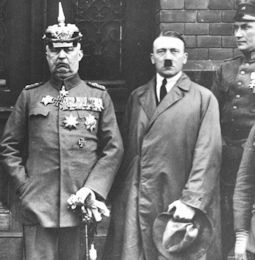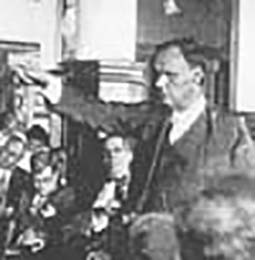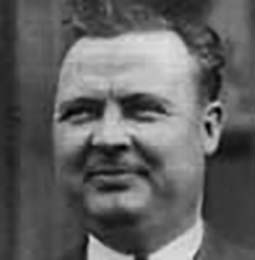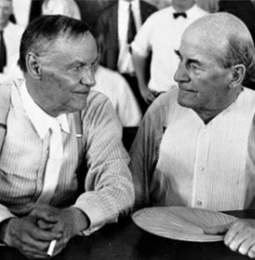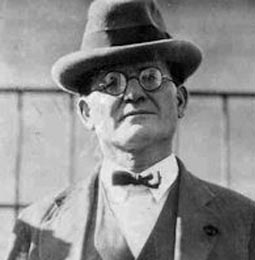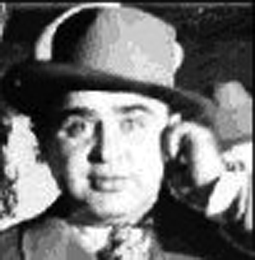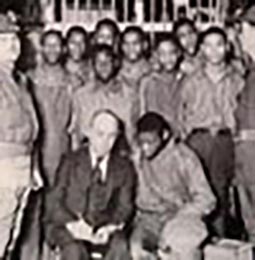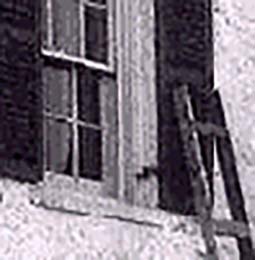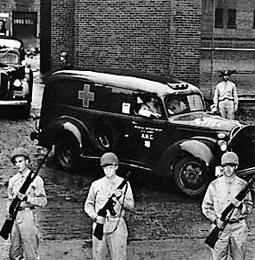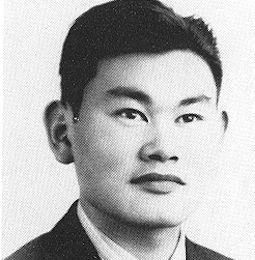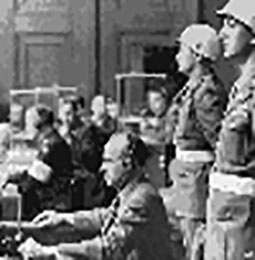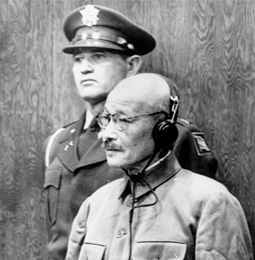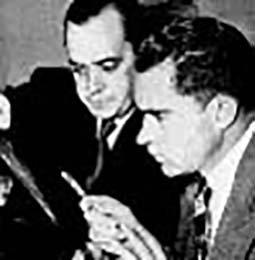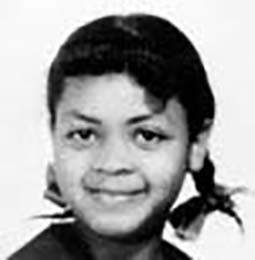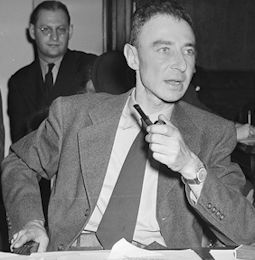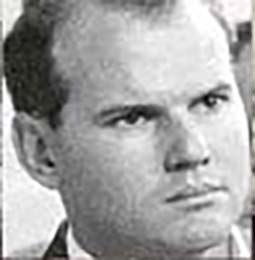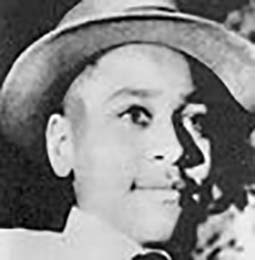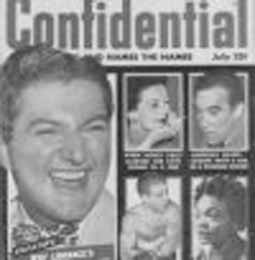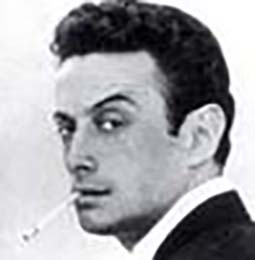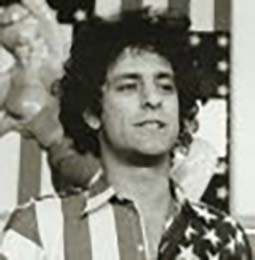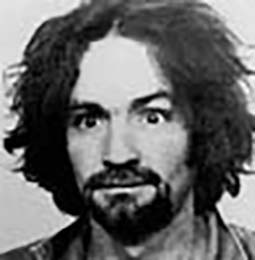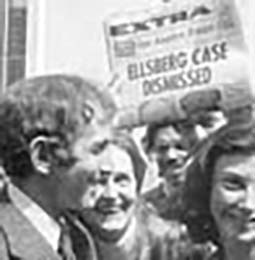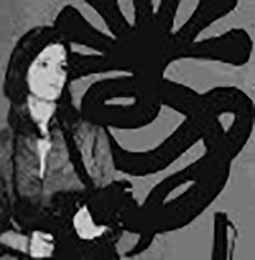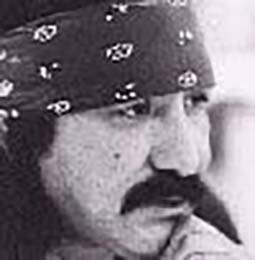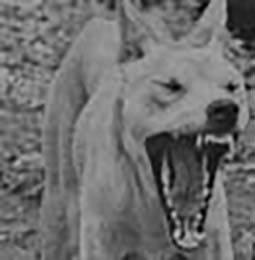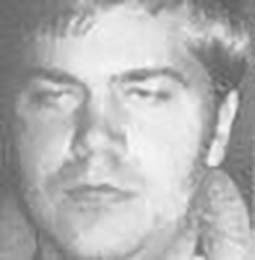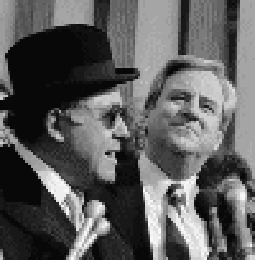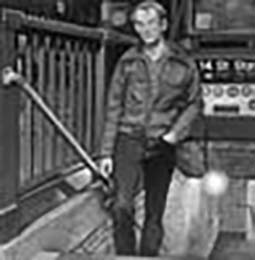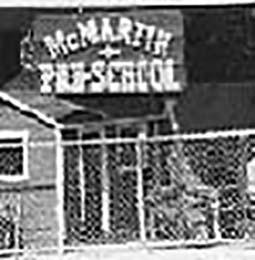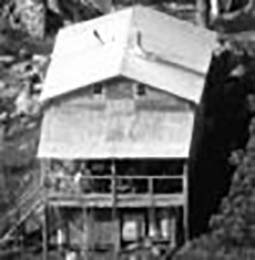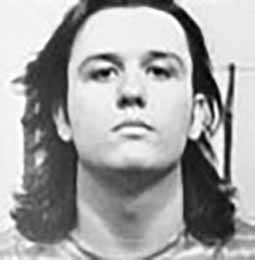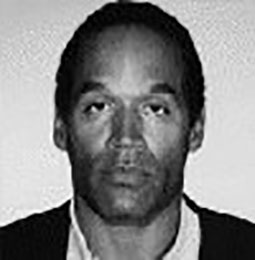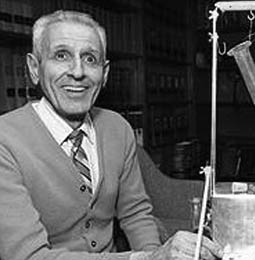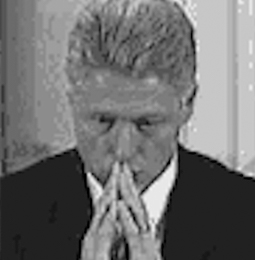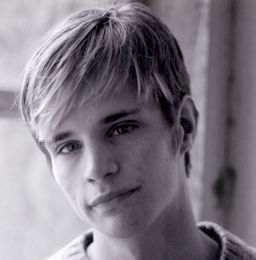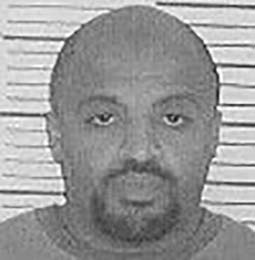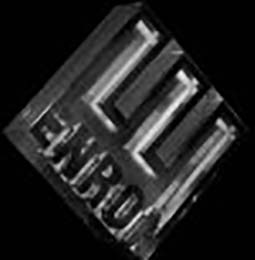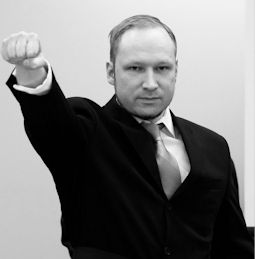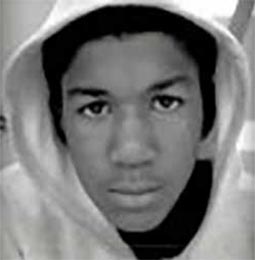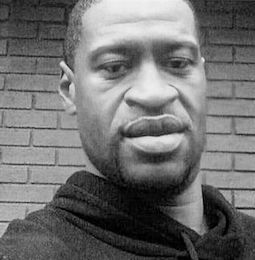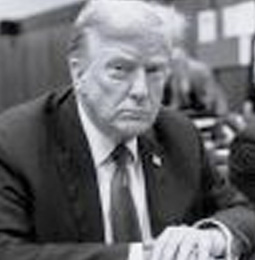Frank v. State
Supreme Court of Georgia.
Feb. 17, 1914.
Error from Superior Court, Fulton County; L. S. Roan, Judge.
Leo M. Frank was convicted of murder, and brings error. Affirmed and rehearing denied.
Fish, C. J., and Beck, J., dissenting.
Leo M. Frank was convicted for the murder of Mary Phagan. The indictment charged that the homicide was committed by choking the victim with a cord drawn around her neck. On the trial the accused was convicted, and sentenced to be hanged. A motion for new trial was made, which, after amendment, was heard and overruled. The defendant excepted.
The homicide occurred in April, 1913. Frank was a married man, and a few days more than 29 years old. He was superintendent of the National Pencil Factory, a company engaged in the manufacture of lead pencils in Atlanta, Ga. There were more than 100 employés at the factory, a large number of whom were girls and women. The business was conducted in a building containing four stories and a basement, located in the business section of the city. The building fronted east 50 feet on South Forsyth street, and extended back about 150 feet to an alley. The entrance to the factory from Forsyth street was through an inclosed hallway on the first floor. Within the hallway, some 25 or 30 feet from the front entrance, there commenced a stairway leading to the second story, ascending in the direction of the rear of the building. This stairway was less than half the width of the hall, and was also inclosed, so that a person ascending, after walking up several steps, would have to pass through a door. The hallway was terminated by a partition constructed across it on a line with the rear of the steps. Through this partition there was a doorway, which afforded means of communication with the other portions of the first floor of the building. There was also an inclosed elevator shaft through the hallway near the foot of the steps. The elevator was operated by the factory, and extended from the basement through the several floors of the building to the fourth story. There *1019 was also in the hallway, located at the front of the steps and behind the elevator shaft, a hatchway through the floor, from which a ladder extended to the basement. The basement contained a boiler, which was used for heating the building, closets for colored people, and rubbish. There was a door opening from the rear of the basement on the alley. The second floor of the building was the first floor of the factory, and will hereafter be referred to as the first floor. The office of the superintendent was on this floor, at the extreme east or front end of the building, overlooking Forsyth street. This was called the “inner office,” and was included within another, called the “outer office.” The elevator shaft through this floor was between the office and the head of the stairs. The elevator was operated by electricity, and the switchboard was on this floor immediately west of or behind the elevator shaft. The rear end of this story of the building immediately back of the head of the stairway was cut off by a partition, and was known as the metal room. There was an entrance to the metal room by means of a double glass door, directly in front of the head of the stairway. There were also stairs from this floor to the third story, and from that to the fourth story, of the building, and the principal business of the factory was conducted in the second, third, and fourth stories above mentioned. A large number of employés worked in the metal room. The usual time for the payment of the employés was 12 o'clock on Saturday of each week. At that time it was a custom of the employés to come to the outer office and receive their pay envelopes, which would be delivered to them from the inner office. On the week of the homicide Saturday fell on April 26th, a legal holiday. On that account the employés were paid off on Friday, and work at the factory was suspended for Saturday.
Mary Phagan would have been 14 years old within a little more than a month, and was physically well developed for a girl of her age. She was an employé of the factory, and her place of work was in the metal room. Her duties were to attach metal tips to pencils. The factory supply of metal was exhausted on Monday, April 21st, and Mary did not report for work any more that week. There was due her $1.20. On Saturday morning she ate an early dinner at her home, consisting of cabbage and bread, and at about 11:45 o'clock boarded a street car, intending to go to the factory for her pay envelope, and, afterwards, to see the parade which was published to occur on the streets at 2 o'clock. She reached the factory shortly after 12 o'clock, and saw the accused, Frank, at his office, and asked him for her envelope. At that time there was no other person on the office floor of the building. There were no other persons working in the building, except two workmen employed on the fourth floor. Frank stated that he delivered her the envelope, which contained $1.20, and that she asked if the metal had come, and that he replied “No,” and that she went out of his office, and that he heard her footsteps as she went away. There was no evidence that she was ever seen alive by any one after that.
At about 3 o'clock that night, Newt Lee, the night watchman, discovered the body of the deceased in the basement near the rear end of the building, and reported the matter to the police by telephone. The body gave evidence that the deceased had come to her death by choking, as alleged in the indictment, and that her person had been otherwise abused. The character and extent of the abuse of her person is more fully set forth in the second division of the opinion.
After the discovery of the body Newt Lee was taken in custody by the officers. Efforts were made to obtain evidence pointing to the offender. Both Lee and Frank denied all knowledge of the crime, and the latter expressed a desire to ascertain the murderer, and to that end participated with his company in employing detectives. He also, while Newt Lee was under suspicion, consented to interview him privately, for the purpose of inducing some statement from him that would lead to the solution of the question, and held a private conference with him on the subject. After making an elaborate statement to the detectives and other officers engaged in the investigation, Frank testified at length before the coroner's jury, denying all the time any knowledge of the perpetrator of the crime, and purporting to give all information at his command leading to the detection of the criminal. Subsequently he was indicted for the offense.
On the trial all that is stated above was virtually without contest, but there was a great deal of other evidence bearing more or less on the case, and most of it conflicting. The controlling question was whether or not Frank was the perpetrator of the crime. Other facts, in so far as necessary to be stated, will sufficiently appear in the opinion.
Reuben R. Arnold, Rosser & Brandon, Herbert Haas, and Leonard Haas, all of Atlanta, for plaintiff in error.
Hugh M. Dorsey, Sol. Gen., and F. A. Hooper, both of Atlanta, and T. S. Felder, Atty. Gen., for the State.
ATKINSON, J. (after stating the facts as above).
1. Testimony was admitted, over objection that it was irrelevant, to the effect that on Sunday morning, after the discovery of the dead body, Newt Lee, while under arrest as the perpetrator of the crime, was composed. There was other evidence to the effect that on the same morning the defendant, Frank, while visiting the corpse and conferring with the officers, was very nervous. The solicitor general commented on the difference between the demeanor of Lee and Frank, as a circumstance pointing to *1020 the guilt of the latter. The body was found in the pencil factory. Frank saw Mary Phagan in the factory alive, and was the last one shown to have seen her. Newt Lee was the watchman at the building, and was the first to report the discovery of the body. The state relied largely on circumstantial evidence to show the perpetrator of the crime. The testimony came from officers who were detailing the incidents of their investigation on the morning after the discovery of the body. They were describing the conditions as found by them, and the conduct and demeanor of the superintendent and night watchman. They proceeded to tell the further developments in the case. Under such circumstances, though it may not have been strictly relevant to describe the demeanor of the night watchman as one of the criteria entering into the investigation, we do not think the admission of the testimony ground for new trial.
2. One of the most important witnesses for the state was James Conley, a negro employé at the factory at the time of and prior to the occurrence of the homicide. He testified that about 8:30 o'clock in the morning of the day of the homicide, which was Saturday and a public holiday, the accused said to him: “I want you to watch for me like you have been doing the rest of the Saturdays.” He continued: “I always stayed on the first floor, like I did on the 26th of April, and watched for Mr. Frank, while he and a young lady would be upon the second floor chatting. On April 26th me and Mr. Frank met at the door. He says, ‘What I want you to do is to watch for me to-day as you did other Saturdays,’ and I said, ‘All right.’ ” The witness testified that he and the accused both were absent from the factory for awhile, and then returned; the witness closely following the accused. He then proceeded with his testimony: “When we got to the factory we both went on the inside, and Mr. Frank stopped me at the door, and when he stopped me at the door he put his hand on the door and turned the door and says, ‘You see you turn the knob just like this, and there can't nobody come in from the outside,’ and I says, ‘All right,’ and I walked back to a little box back there by the trash barrel. He told me to push the box up against the trash barrel and sit on it, and he says, “Now, there will be a young lady up here after awhile, and me and her are going to chat a little,' and he says ‘Now, when the lady comes I will stomp like I did before,’ and he says, ‘That will be the lady, and you go and shut the door,’ and I says, ‘All right sir,’ and he say, ‘Now, when I whistle I will be through, so you can go and unlock the door and come upstairs to me office like you were going to borrow some money from me, and that will give the young lady time to get out.’ I says, ‘All right, I will do just as you say,’ and I did as he said.” He further testified that he saw the girl who was killed go upstairs; that he heard her footsteps going towards the office of the accused, and after she went into the office he heard two people walking out of it and going back toward the metal department; that after they did so he heard the girl scream, and then heard no more; that he then saw another girl enter the building, go upstairs, then come down and leave the building; and that he then heard some one running from the metal department on tiptoe and afterward returning to that department in the same manner. He then testified: “About that time I kind of dozed off and went to sleep. Next thing I knew Mr. Frank was up over my head stomping, and then I went and locked the door and sat on the box a little while, and the next thing I heard Mr. Frank whistling. I don't know how many minutes it was after that I heard him whistle. When I heard him whistle, I went and unlocked the door just like he said, and went on up the steps. Mr. Frank was standing up there at the top of the steps, shivering and trembling and rubbing his hands like this. He had a little rope in his hand, a long, wide piece of cord. His eyes were large, and they looked right funny. He looked funny out of his eyes. His face was red. Yes, he had a cord in his hands just like this here cord. After I got up to the top of the steps, he asked me, ‘Did you see that little girl who passed here just awhile ago?’ and I told him I saw one come along there and she came back again, and then I saw another one come along there and she has not come back down, and he says: ‘Well, that one you say didn't come back down she come into my office awhile ago and wanted to know something about her work in my office, and I went back there to see if the little girl's work had come, and I wanted to be with the little girl, and she refused me, and I struck her, and I guess I struck her too hard, and she fell and hit her head against something, and I don't know how bad she got hurt. Of course, you know I ain't built like other men.’ ” He testified to having assisted the accused to move the body from the second floor of the building to the basement, where it was subsequently found; and also gave evidence tending to show that on various Saturday afternoons, during several months preceding the homicide, the accused had received women in his office, had indulged in lascivious practices with them on a number of occasions, and had also had another man (named Dalton) and a woman present on several occasions. In connection with these visits of Dalton and the other woman and their indulgence in improper practices, he said: “Mr. Frank called me in his office. There was a lady in there with him. * * * She was present when he talked to me. He said, ‘You go down and see nobody don't come up, and you will have a chance to make some money.’ The other lady had gone out to get that young man, Mr. Dalton.”*1021 He further testified that Dalton and the woman returned, and he let them into the basement; that he watched at the door; that when they went to leave Dalton gave him a quarter; and that Dalton gave him money on other occasions when he came to the factory with the woman for lascivious purposes.
After the witness had testified that Frank said, “Of course, you know I ain't built like other men,” he was asked, “What did he mean?” and testified: “The reason he said that was I have seen him in a position I haven't seen any other man that has got children. I have seen him in the office two or three times before Thanksgiving, and a lady was in his office, and she was sitting down in a chair and she had her clothes up to here (indicating up to her waist), and he was down on his knees, and she had her hands on Mr. Frank. I have seen him another time there in the packing room with a young lady lying on the table. She was on the edge of the table when I saw her.” In one ground of the motion for new trial, this begins, “Well what I taken it to be,” etc.; but it is set out in the brief of evidence as above stated, and another ground of the motion substantially follows the brief of evidence.
At a later stage of the trial, counsel for the accused moved to have withdrawn from the jury and excluded from evidence the testimony of Conley in relation to acts and conduct of the accused on former occasions, and in regard to the watching of the witness for the accused at previous times, and also especially moved to have excluded the evidence last quoted. We think this evidence was relevant and admissible, for several reasons. In the first place, the witness had testified that on the day of the homicide the accused said to him, “I want you to watch for me like you have been doing the rest of the Saturdays,” or “as you did other Saturdays.” He was then asked, “Now, tell what kind of work you had done for him the other Saturdays;” and in answer to this, and other questions, the testimony was brought out in reference to the practice of the accused to indulge in lascivious conduct in his office and in the building on Saturday afternoons, and to have the witness watch for him to prevent detection. As showing the occasion for his presence at the factory at the time when the crime was committed, and as explaining his peculiar opportunity for knowledge in regard to it, and why the accused should call on him to assist in watching, and subsequently in removing the body, and especially in order to explain the statement that he was employed on that Saturday as he had been on other Saturdays, it was competent to show how he had watched and for what purpose on other Saturdays. Having testified that the accused had made reference to what the witness had formerly done, in directing him what he was then to do, no reason occurs to us why he should not explain the reference.
Again, the witness had testified that after the homicide the accused called on him to assist in removing the body of the girl from the place where she was slain, not far from the office of the accused, and that in explaining to him the situation, the accused stated: “I wanted to be with the little girl, and she refused me, and I struck her, and I guess I struck her too hard, and she fell and hit her head against something, and I don't know how bad she got hurt. Of course, you know I ain't built like other men.” According to the witness, here was a statement by the accused in connection with the homicide and its cause, arising from his lecherous desires and the effort to accomplish them. What did he mean by not being built like other men? As testified to by this witness, it was something that he knew and the witness knew which indicated abnormality. It was something that the accused thought of sufficient importance to refer to in connection with the homicide and its cause. Were the jury to be left in the dark as to what it was that he knew and Conley knew that indicated such abnormal or perverted conduct in connection with the murder? Why should not the jury be permitted to understand what the accused was talking about that was a subject of common knowledge between him and the witness? However black it may indicate the conduct of the accused to have been, there was no reason why the jury should be left in the dark in regard to it. Suppose on the trial of one accused of murder it should be sought to show that the accused was armed with a deadly weapon, and a witness should testify that the accused said to him about the time of the homicide, “You know what I always carry in my pocket.” Would there be any doubt that the witness would be allowed to testify that the accused had previously informed him that he always carried a pistol, or had on previous occasions exhibited to him a pistol in his pocket? Or, on the trial of one accused of gambling in a certain room, or of keeping a gambling house there, if the state should introduce a witness who should testify that the accused had posted him on the outside of the room to watch and warn him against the approach of any stranger, and had said to the witness that the latter knew what they always did in that room, would it be contended that it would not be competent to show by the witness that the accused and others on previous occasions had gambled in the room while he was watching for them, as explanatory of the inculpatory statement of the accused? This evidence was not admissible merely because it may have shown previous improper conduct or criminality on the part of Frank, disconnected from the crime with which he was charged, but because it threw light on the transaction under consideration and tended to explain what he said and did on that occasion as testified to by the witness. So far as our search has extended, we have found no case where the *1022 conduct and language of one accused of a crime, and closely connected therewith by evidence, could not be explained by showing other conduct to which he himself referred.
In McCray v. State, 134 Ga. 416, 68 S. E. 62, 20 Ann. Cas. 101, the court, over objection, allowed a witness to testify that the accused referred to “Mr. Z. S. Warnell,” the deceased, “when he said he was expecting them.” It was held that this was a mere opinion, surmise, or conjecture of the witness, and was not admissible. But this presents an entirely different case from one where a person accused of murder, in calling on another to assist him in removing the body, and where a lecherous motive is involved, says to the witness, “You know I ain't built like other men.” For the witness to state what they both knew on that subject was not a mere expression of opinion, or a surmise, but a statement of fact. Moreover, no objection was made in the present case to this evidence on the ground that an opinion was asked for, but on the ground of irrelevancy. Goodtitle v. Roe, 20 Ga. 135 (5).
The testimony of the undertaker who prepared the body for burial, and that of a physician who made an autopsy and certain microscopical investigations, tended to show that the sexual organ of the girl indicated external violence. The physician found no indication of spermatozoa in the uterus, or upon her person or garments. The epithelium of the walls of the vagina was torn and bruised. Her drawers were cut or ripped up the seam, and blood was found upon her garment. From this testimony, it was inferable that the slayer undertook to have some sort of relation or connection with her sexual organ, and possibly in an unnatural way. Under these circumstances, the evidence above stated, to which objection was made, was plainly admissible to explain the conduct and language of the accused in connection with and at the time of the homicide.
It is contended that proof of independent crimes was not admissible on the trial of the accused for murder. A theory of the state, which finds a basis in the evidence, was that the murderer desired to have a sexual relation of some character, natural or unnatural, with the deceased; that she resisted his attempt for that purpose; that he struck her, not with the intent at first to kill her, but in pursuance of his purpose above mentioned; that the blow produced unconsciousness; and that, in fear of her regaining consciousness and that his criminality would be exposed, he choked his victim with a cord. Here the question of whether the accused had a motive in regard to his conduct on that occasion which might induce him to commit the homicide, in the effort to carry out his purpose, was of the utmost materiality. The general rule on this subject has been stated by the Court of Appeals of New York in People v. Place, 157 N. Y. 584, 52 N. E. 576: “It is an elementary principle of law that the commission of one crime is not admissible in evidence upon the trial for another, where its sole purpose is to show that the defendant has been guilty of other crimes, and would, consequently, be more liable to commit the offense charged. But, if the evidence is material and relevant to the issue, it is not inadmissible because it tends to establish the defendant's guilt of a crime other than the one charged.” In McCommons v. Williams, 131 Ga. 313, at page 319, 62 S. E. 230, at page 233, a similar principle was recognized in a civil case. It was said: “If evidence is admissible on behalf of the defendant for any purpose, though its effect on the plaintiffs' case may be serious, this will not make its admission erroneous as irrelevant.” See, also, Nugent v. Watkins, 129 Ga. 382 (2), 385, 58 S. E. 888.
Under this doctrine, collateral facts are not to be rejected merely because they may show the commission of some crime other than that for which the accused is on trial, but they will be admitted, notwithstanding they may show the commission of other crimes, if they tend to illustrate the defendant's guilt or innocence of the crime for which he is being tried. In 3 Bishop's Crim. Proc. (2d Ed.) § 629, subsec. 4, it is said: “Any motive rendering the killing probable or explaining it against inherent improbabilities, or otherwise helpful to the jury as a circumstance, may be proved against the defendant.” In People v. Molineux, 168 N. Y. 264, 61 N. E. 286, 62 L. R. A. 193, the subject of the admissibility of evidence on the trial of one indicted for murder, which tended to prove other crimes, was considered at length, both in the opinion of the majority of the court, rendered by Werner, J., and in the dissenting opinion of Parker, C. J. Many cases bearing on the subject are also cited in the note to the same case in 62 L. R. A. 193. To undertake to discuss the numerous decisions on this subject would unduly prolong this opinion. We will only refer to a few of them. In the Molineux Case, Werner, J., said: “Generally speaking, evidence of other crimes is competent to prove the specific crime charged when it tends to establish: (1) Motive; (2) intent; (3) the absence of mistake or accident; (4) a common scheme or plan embracing the commission of two or more crimes so closely related to each other that proof of one tends to establish the others; (5) the identity of the person charged with the commission of the crime on trial.” In that case it was contended by the state that the accused had caused the death of the decedent by sending through the mail a bottle which purported to contain bromo seltzer, but which contained also, mixed with the bromo seltzer, a powerful poison, with intent to kill another person. Evidence was offered to show that another person had received by mail another powder purporting to be Kutnow powder, with which was also mixed *1023 the same powerful poison, and that this had produced the death of the person to whom it was sent. There was certain other evidence which it was claimed tended to point to the fact that the accused sent both powders. The majority of the court held that the evidence in regard to the murder of the other person was not admissible. In the opinion of Werner, J., in discussing the question of motive, he based his argument in regard to the inadmissibility of the evidence mentioned upon the fact that the motive for the two murders was different. He said that the motive assigned for the attempt to kill the person to whom the poisoned bromo seltzer was sent was hatred engendered by quarrels between him and the accused, in which the person to whom the poisoned Kutnow powder was sent took no part, and of which, so far as the record shows, he had no knowledge; while the motive which was said to have moved the defendant to kill the person to whom the poisoned Kutnow powder was sent was jealousy caused by the latter's intervention in the love affairs of the accused. He therefore declared that the statement of these two motives was sufficient to show that they had no relation to each other, and that the evidence which tended to prove the one killing threw no light upon the motive which actuated the other attempt. In the case now before us, the common motive of lechery pervaded not only the homicide, but also the other transactions in regard to which evidence was admitted, and there was a sufficient approximation in point of time and place as to all. In his able dissenting opinion, Parker, C. J., after stating the general rule that evidence of the commission by a person of other crimes is not admissible upon the trial of a defendant, added: “But it has never been held by any court of respectable authority that the people cannot prove the facts constituting another crime when those facts also tend to establish that the defendant committed the crime for which he is on trial. Such a holding would accomplish the absurd result of permitting a rule intended to prevent the defendant from being prejudiced in the eyes of the jury because of his life of crime to so operate in certain cases as to prevent the people from proving the facts necessary to convict him of the crime charged.” The opinion of Werner, J., cites, in support of his statement above quoted, Wharton's Criminal Evidence. A reference to the tenth edition of that book, recently issued from the press, will show that the author does not confine the exceptions to the general rule strictly to those enumerated by Judge Werner. 1 Wharton's Crim. Ev. (10th Ed.) § 31. In People v. Harris, 136 N. Y. 423, 33 N. E. 65, it was held, in the prosecution of a man for the murder of his wife, that evidence that seven months after his marriage to the deceased the defendant was at a hotel in illicit relations with another woman, to whom he suggested that she marry some old man with plenty of money, and that if she found one they could give him a pill and get him out of the way, was admissible on the question of motive, though it tended to show the commission of another and distinct crime, and involved the character of the accused. It will be seen that the evidence was not admissible to prove the general character of the accused, but was admissible as tending to show motive, although incidentally it involved his character. The English poisoning cases go quite far. In R. v. Cotton, 12 Cox's C. C. 400, it was held that where a prisoner was charged with the murder of her child, and the defense was that its death resulted from an accidental taking of such poison, evidence to prove that two other children of hers and a lodger in her house had died previously to the present charge from the same poison was admissible. In Makin v. Attorney General, 17 Cox's C. C. 704, certain persons were indicted for the murder of an infant child, whom they had taken in to nurse upon payment of a small sum, alleging that they desired to adopt it as their own. It was held that evidence that several other infants had been received by the prisoner on like representations and upon the payment of sums inadequate to support them for more than a short time, and that bodies of infants had been found in the gardens of several houses occupied by the prisoners, was admissible. See, also, People v. Wood, 3 Parker, Cr. R. 681.
Another ground on which evidence may be received, although it includes proof of a different crime, is to show a common scheme or plan of related offenses. In Commonwealth v. Ferry, 146 Mass. 203, 15 N. E. 484, the defendant was charged with being present in a certain room and engaged in the business and employment of registering bets and selling pools. It was held that evidence was admissible to show that the room during the ten days next preceding the day of the alleged commission of the offense was used for that purpose. In Robinson v. State, 53 Md. 151, 36 Am. Rep. 399, a man was charged with burglary. At the trial he offered to prove that the owner of the house was a lewd woman, and that he had had improper intimacy with her. It was held that it was error to reject such evidence as tending to show what his real intent was in breaking into the house. In State v. Ames, 90 Minn. 183, 96 N. W. 330, on an indictment for bribery in paying for protection of an unlawful occupation, it was held that evidence of payments by others to one who was acting as collector of the money was admissible as part of a common scheme or plan instigated and carried on by the defendant and such person to solicit and receive such bribes. In State v. Desmond, 109 Iowa, 72, 80 N. W. 214, it was held that on a trial for an assault with intent to rape, where indecent acts of the defendant towards other young girls at about the same time, though separate and distinct *1024 from each other, were parts of a single transaction, proof of them all was admissible to show the intent with which the defendant acted. In Hays v. State, 40 Md. 633, it was held that, where a party is being tried for having produced an abortion upon one who at the time was an inmate of her house, it was competent to show the character of the house--that is, a house of ill fame--in order that the jury may know whether the place is one where the crime could be committed without fear of detection and punishment. In Proper v. State, 85 Wis. 615, 55 N. W. 1035, in a prosecution for rape committed upon a child ten years of age, it appeared that she and another girl slept together in the defendant's house. Evidence that the defendant got in the bed and had sexual intercourse with the other girl was held admissible as tending to render more credible the evidence of the prosecuting witness.
Counsel for the defendant rely on the decision in State v. La Page, 57 N. H. 245, 24 Am. Rep. 69. While some of the language used in that case is general in its character, yet it must be considered in reference to the actual questions decided. La Page was indicted for the murder of one Josie A. Langmaid in October, 1875, the government claiming that the murder was committed in perpetrating or attempting to perpetrate rape, while she was passing over the Academy road on her way to school. One piece of evidence to which objection was made was the testimony of one Julienne Rouse, which tended to prove that the prisoner about four years and a half before the trial, at a place beyond the jurisdiction of the United States, committed the crime of rape upon a person other than the deceased. This was admitted by the trial court, and this was held to be error by the Supreme Court. In the opinion it was said (57 N. H. page 287, 24 Am. Rep. 69): “The question is whether the bald, naked fact being put in evidence had any tendency to prove any matter in issue between the state and the defendant.” The testimony of other witnesses was introduced in regard to the conduct of the accused not long before the homicide and in the neighborhood of the scene of the crime, though it involved also other females. In regard to this class of evidence, Cushing, C. J., said (57 N. H. page 287, 24 Am. Rep. 69): “The testimony of Fowler, Mahair, the Towles, the Watsons, and Mercy was, I think, properly admitted. It all tended to show that the prisoner, about the time of the murder, was frequenting that neighborhood with a view of the commission of the crime of rape upon the person of some one of the young females whom he knew to have occasion to pass over that road. The obscene and filthy language he is described as using, in connection with his inquiry about one of the young ladies, tends to show what thoughts were in his mind, and what he was meditating. The testimony of the Watsons and Mercy tends to show, not merely an intent or design to commit the crime on the person of Miss Watson, but also to show generally, in connection with the other testimony, that he was prowling about that place for the purpose of lying in wait for any person whom he might sacrifice to his base and cruel designs. It furnishes an illustration of the doctrine which I shall attempt to illustrate and maintain. The attempt to commit one offense may be put in evidence when attended with circumstances which give it a logical connection with the fact in issue, and not otherwise.” It will thus be seen that, when considered as a whole, the decision is not antagonistic to the position which we now take, but in fact strongly supports it. It is not contended that an entirely distinct and separate crime occurring several years before the homicide for which the accused was on trial, and in no way connected with it, could be proved merely for the purpose of supporting a claim that a man who had committed one crime might commit another. But what we hold is that, where the former transaction has a logical connection with the fact in issue, it can be proved, although it may be a crime.
Again, counsel for the defendant quote in their brief, and rely upon a paragraph in 1 Wigmore on Evidence, § 194, which begins with the expression, “It may almost be said that it is because of this indubitable relevancy of such evidence that it is excluded,” and proceeds to discuss the danger of prejudice being raised in the minds of the jury by a previous vicious criminal record. This citation is not relevant to the subject which we are now discussing. In that connection the author was discussing the proof of the defendant's character by showing particular bad acts. No one is contending in the present case that distinct and disconnected crimes could be proved merely to show that the defendant had a general bad character.
Counsel for the defendant also rely strongly upon the case of Cawthon v. State, 119 Ga. 395, 46 S. E. 897. In regard to that decision several remarks may be made. In the first place, it was made by a majority of the court. Presiding Justice Fish (now Chief Justice) and Mr. Justice Candler dissented. The present Chief Justice dissented on the ground that on account of the manner in which the case was brought to this court the rulings of the court below could not be reviewed. If this position was correct, and the Supreme Court had no jurisdiction to decide the case, what was said in regard to it was not authoritative. Mr. Justice Candler went further, and said that the majority of the court erred in applying the rule. Again, Mr. Justice Cobb, who prepared the opinion of the majority of the court, did not attempt to lay down a rule comprehending all possible cases in which evidence might be admissible, although it showed previous crimes. On page 409 of 119 Ga., page 901 of 46 S. E., after referring to the general *1025 rule that it is not competent to prove a distinct and independent offense, he said: “While this rule is general and subject to few exceptions, still there are some exceptions; as when the extraneous crime forms part of the res gestæ; or is one of a system of mutually dependent crimes; or is evidence of guilty knowledge; * * * or where it tends to prove malice, intent, motive, or the like, if such an element enters into the offense charged. * * * In order to justify the admission of evidence relating to an independent crime committed by the accused, it is absolutely essential that there should be evidence establishing the fact that the independent crime was committed by the accused, and satisfactorily connecting that crime with the offense for which the accused is indicted.” It will thus be seen that, after stating that there were some exceptions to the rule, the use of the words “as when,” etc., was illustrative, and did not undertake to lay down a complete category of exceptions. This is further borne out by the use of the expression “malice, intent, motive, or the like,” and of the last statement above quoted. That decision did not hold that if there was a logical connection between the two transactions, connecting the two together, so that the one threw light upon the other, the former would be excluded though it might be a crime.
This court has recognized the wide range of evidence which might be admitted where the motive is a legitimate subject of inquiry. And let it be noticed that, when the word “motive” is here used, it does not mean a mere abstract question as to whether there could have been a possible motive for somebody or anybody to have committed a murder, but whether the accused had a motive which the jury might find induced him to commit it. In Shaw v. State, 102 Ga. 660, 29 S. E. 477, where the accused was indicted for wrecking a railroad train, whereby death ensued, it was held that there was no error in admitting in evidence a declaration made by the accused prior to the wreck, while discussing with the witness another wreck which had occurred a short time before, to the effect that he “was going to have a wreck of his own some day.” Again, where it appeared that the defendant's wife was a passenger on the train which was wrecked, and that she was there by his direction, it was held to be not error to admit evidence that he had become enamored of another female, and had made to her a proposition of marriage, which, prior thereto, had been rejected. It was said that such evidence was admissible as bearing on the motive which might have induced the accused to commit the act. The wife was not the person killed. It is true that this evidence bore upon the question of whether the accused had a motive to take the life of his wife by means of wrecking the train. But it will be perceived that the remark which was admitted was general, and that the act which was shown in regard to the other woman was previous to the occurrence of the wreck, and was not shown to have any more direct connection with it than to throw some light upon the probable motive which the accused had. This latitude of evidence to show motive has been recently recognized by this court, in Johnson v. State, 128 Ga. 71, 57 S. E. 84. In that case the accused was indicted for the murder of his father. A witness for the state was permitted to give testimony to show that the accused, at the time of the homicide, was living in needy and indigent circumstances; the court having previously admitted evidence to establish the fact that the defendant knew that the deceased, the father, had insurance upon his life and had money in bank. It was held that the testimony was properly admitted. It was said in the opinion: “Such evidence is admissible under the rule that evidence going to show motive is always material and relevant to the issue on the trial of one for murder, where the accused denies the act of killing.” In Bulloch v. State, 10 Ga. 47, 54 Am. Dec. 369, on the trial of a bank officer for embezzlement, evidence that he was in straitened circumstances, and had been buying lottery tickets to a large amount, was held to be admissible. The evidence of guilt was circumstantial. Warner, J., said (10 Ga. page 55, 54 Am. Dec. 369): “When a great crime has been committed, it is important to inquire whether the accused party was influenced by any motive to commit such an offense, for the absence of all motive to commit the offense charged against him affords a strong presumption of his innocence; whereas, if it appears on the contrary, that he was influenced by a very strong motive to commit the particular offense charged, the probability of his guilt is necessarily greatly strengthened.” So, in the case before us, there was no eyewitness to the crime, and the evidence under discussion tended to show a lascivious motive on the part of the accused which had several times in the near past been exhibited at that place, and under like circumstances of watching and signaling, and from the effort to act upon which, at the same place, on this occasion, and resistance thereto, the murder may have resulted. In Nesbit v. State, 125 Ga. 51, 54 S. E. 195, on the trial of one indicted for assault with intent to murder, evidence was admitted that the accused, on the morning after the assault for which he was tried, accosted the prosecutor and demanded of him, “What you been tending to my business for?” that the prosecutor denied interfering with the defendant's business, and that thereupon the accused advanced upon the prosecutor and drew and opened a knife--with other details of this subsequent transaction, none of which showed any relation to the transaction for which the accused was tried. It was held that the admission of this *1026 evidence was error, and that it fell within the general rule of exclusion. The difference between that case and the present one is clear. In Alsobrook v. State, 126 Ga. 100, 54 S. E. 805, the accused was indicted for obstructing a railroad track. Evidence of prior attempts to obstruct the railway track was admitted. Presiding Justice Cobb, the same justice who wrote the opinion in the Cawthon Case, recognized the rule that: “Evidence of prior attempts by the accused to commit the same crime upon the victim of the offense for which he stands charged is admissible; or where other offenses committed by the accused tend to prove malice or motive, or the like, evidence of other offenses is sometimes admitted.” The Cawthon Case was cited. But it was held that: “Some of the evidence admitted in the present case as to prior attempts to obstruct the track of the railway did not connect the accused in any way with such prior attempts. This evidence was inadmissible and highly prejudicial to the accused.” The judgment was reversed, all the justices concurring, except Fish, C. J., absent. Of course, if no connection was shown between the defendant and the previous transaction, it would be inadmissible. In Sullivan v. State, 121 Ga. 183, 48 S. E. 949, certain persons were indicted for causing the death of an unborn child with which the pregnant woman was then quick, by instruments and pressure. Evidence was held competent to show that the defendant on trial had previously attempted to procure an abortion by similar means and by the use of medicine, although the indictment contained no reference to medicine. It was said that there was a logical connection between the two attempts to procure an abortion on the female. The Cawthon Case was again cited.
In Grantham v. State, 95 Ga. 459, 22 S. E. 281, where in a trial for burglary it was shown that the accused had possession of goods taken from the storehouse alleged to have been broken into, and that he, not denying this fact, contended that he and the owner were on friendly terms, that they frequently drank and gambled with each other, and that the goods in question were won from the owner in a game of cards, all of which was denied by the latter in his testimony, and where the time of the alleged burglary was left uncertain by the evidence, it was held to be error to refuse to allow the accused to prove that before and after the time of the burglary he and the prosecutor were seen in the latter's store and at other places gaming, and that the prosecutor was drunk at his store both before and after the alleged burglary. This recognized a logical connection between the transactions. In Farmer v. State, 100 Ga. 41, 28 S. E. 26, on the trial of one for the offense of being a common cheat and swindler, alleged to have been committed by making false and fraudulent representations concerning the wealth and commercial respectability of the accused, and thus obtaining the goods of the prosecutor, it was held competent for the state to prove that the accused at or about the same time made similar representations to another for the purpose of fraudulently obtaining his goods, as tending to show a fraudulent intent and scheme on the part of the accused to obtain the property of others without paying therefor, and as warranting an inference that the transaction with the prosecutor in the case was made in pursuance of the same general purpose.
It would serve no useful purpose to take up each of the cases decided by this and other courts on the subject of the admissibility of evidence of distinct and separate offenses, having no logical connection with that for which the accused is on trial. What has been said above, we think, sufficiently indicates the general rule and some of the exceptions. Let us now refer to the facts of the present case. There was no question that the girl was killed, and that her body was found in the factory of which the accused was the superintendent. There was evidence from which the jury could find that the killing occurred on the second floor, on which was located the office where the accused admitted that he was when the girl entered the building, went to the office, and spoke to him. There was also evidence from which it might be inferred that the person who committed the crime sought to have some character of sexual relation, natural or unnatural, with the girl. Practically all other persons were eliminated from suspicion except the accused and Conley, the leading witness for the state. The accused was a white man, married, and superintendent of the factory. The witness was a negro employé, who admitted that he drank intoxicating liquors. Naturally it would be urged with great earnestness to the jury that there could be no possible motive why the accused should kill one of the employés of the factory, and that it would be improbable that he would indulge in lechery in his office or in his place of business, while the negro sweeper would be more likely to do so. Thus the question, not whether some unknown criminal had a lecherous motive, but whether or not the accused had a lecherous motive which might lead to the effort to accomplish it upon the girl, and, upon her resistance, then to murder, was vitally involved. The question would naturally be asked: What motive was there to prompt the accused to commit the act? The evidence tended to show a practice, plan, system, or scheme on the part of the accused to have lascivious or adulterous association with certain of his employés and other women at his office or place of business, in which place the homicide occurred. Some of these acts were shown specifically to have occurred not long before the homicide, and others must have taken place at no great distance of time, because Conley was only employed at *1027 the factory a little more than two years. It tended to show a motive on the part of the accused, inducing him to seek to have criminal intimacy with the girl who was killed, and, upon her resistance, to commit murder to conceal the crime. There was not only evidence of the practice of the accused with other women, but during the trial there was also introduced evidence tending to show that in pursuance of his general practice he made advances toward the deceased. We think that the evidence was admissible, both on the subject of motive and of plan, scheme, or system, and as tending to show identity. If it is suggested that his conduct in regard to having lascivious relations with other women did not show any intent to violate the deceased, this would be to put too narrow a construction upon the subject of motive and plan. If a man should construct a pit with the general purpose of catching the ewe lambs of his neighbors, it would be trivial to say that, if charged with catching a certain one, he did not have that particular lamb in view when he dug the pit, or that, if she were killed in the effort to capture her, the digging of the pit and using it were immaterial. If the defendant was conducting a general plan or scheme of gratifying his lascivious desires at that place, and in connection therewith he sought to have intimacy with the deceased girl, in order to show motive it is not necessary that from the beginning and throughout the plan he had in mind ultimately to use force upon or kill this particular girl. The intent to kill may have arisen pending the effort to accomplish his design. To follow such a suggestion would be to confuse motive, or that which incites, prompts, or induces action, with intent, or specific purpose. From the language of one of the headnotes in Alsobrook v. State, supra, some contention of this sort might be drawn. But on examining the opinion, and the Cawthon Case, from which the headnote purported to have been copied, it will be seen that it omits a material part of the original sentence, so as apparently to create a possible limitation which the entire sentence does not authorize.
Certain evidence of one Dalton was also admitted. This was likewise admissible under what has been said above. As has been stated in another part of this opinion, Conley testified to the effect that Dalton and the accused consorted together in their libidinous practices in the factory; that the accused had the witness to watch at the door while these practices were going on; that he told the witness that he might make money by watching for Dalton as well as for the accused; that the witness did so; and that Dalton paid him, as Frank suggested. Thus Dalton was coupled with the accused in the practices going on in the factory on Saturday afternoons, and was directly connected with the accused by the statement of the latter. The witness Conley was attacked by the accused both in the cross-examination and subsequently by the testimony of witnesses introduced to impeach him. If the evidence of Conley was admissible, as we have attempted to show, that of Dalton tended to corroborate him as to the connection between Conley and Frank, and as to the watching by the former and as to the practice or scheme of the latter. The point that we are now dealing with is in regard to the admissibility of evidence, and not to its credibility. The latter question was passed upon by the jury, and the judge declined to set aside their verdict.
3. The court admitted testimony to the effect that, while the defendant was in jail, the detectives, in company with Conley, appeared at the jail and requested an interview with the defendant, and that the latter declined, assigning as a reason that his lawyer or any one interested in him was not present. This testimony was objected to on the ground that it was irrelevant and immaterial. The evidence would ordinarily be open to the objection; but there was other evidence to the effect that prior to this the accused had assumed an attitude of innocence and of attempting to aid the officers in identifying the murderer, and had requested the officers of his company to employ detectives (and a detective so employed took part in proposing the interview with Conley), and had made statements professing to disclose all the facts and circumstances relating to the murder, so far as known to him, and at the instance of the detectives had interviewed Newt Lee, who at the time of the interview was suspected by the officers and held as the perpetrator of the crime. There was evidence tending to show that Lee was not a participant in the crime, but that Frank was the real murderer, and had called upon Conley to dispose of the body immediately after the homicide. If this were true, and Frank was feigning innocence, he might well have confronted Lee, whom he knew had no knowledge of the circumstances, but it would be a different matter to confront Conley, who he knew did know them. The fear of bringing out damaging evidence by an interview with Conley might have been the cause of declining the interview, rather than the reason which the accused assigned for the refusal, namely, that neither his lawyer nor any one interested in him was present. This would be a proper matter of inquiry by the jury, and the refusal of Frank to have an interview with Conley was relevant.
4. One of the material matters of inquiry was the length of time intervening between that at which Mary Phagan left her home and her death. Just prior to leaving home, Mary had partaken of a meal consisting of wheat bread and cabbage. An expert was called, who, from an analysis of the contents of the stomach, with reference to the progress of the processes of digestion, *1028 testified to the probable length of the intervening time. Prefatory to detailing his testimony in this respect, the witness was allowed, over objection, to state the result of experiments made by him with other stomachs at different times, with regard to the digestibility of cabbage. This testimony was competent, and it was proper to allow the witness to give the details of his experiments in connection with the subject-matter of the digestibility of cabbage and the time consumed in the process of digestion. 5 Enc. Ev. 495.
5. Two physicians who testified, one for the state and one for the defendant, were, respectively, the secretary and the former president of the state board of health. The testimony of these two physicians was in the nature of expert evidence, and differed in important particulars. When the physician testifying for the accused was upon the stand, he was asked by defendant's counsel, on the direct examination, if he had any personal feeling against the physician who testified for the state, to which he replied, “No,” but that he had preferred charges with the state board of health, charging the latter with professional dishonesty. The prosecution was allowed to reply to the testimony by the introduction of voluminous extracts from the minutes of the state board of health, to the effect that charges had been preferred and had been investigated, and, as a result of the investigation, a resolution had been adopted declaring that while there existed certain slight irregularities in the conduct of some of the departments of the laboratory of the state board of health, which should be corrected, these irregularities had not been so important in character or result as to call for or warrant the discontinuance of the secretary and director of laboratories as demanded by the president; and the resolution further provided that a copy should be transmitted to the Governor. Whereupon the president tendered his resignation, and the same was accepted. While some of the evidence objected to was admissible, much of the testimony relating to the merits of the controversy between the president and secretary of the state board of health was foreign to any issue involved on the trial of this case. The testimony was provoked by a question propounded by counsel for the defendant on the direct examination of his witness, and, though not admitting the rule of equation of errors, we are unable to see how this controversy between the two physicians obscured any issue in the case, and the reception in evidence of the extract from the minutes of the state board of health is not ground for new trial.
6. One question as to which there was conflict in the evidence was as to the time when the deceased girl reached the factory. The accused contended that she reached the factory at 12 minutes after noon. The state contended that she arrived a few minutes sooner. The time was made specially material by the testimony of another girl, who stated that she arrived at the factory at 12:05 p. m., went into the office to see the accused, but found him absent therefrom, and left the building at 12:10 p. m., according to the factory clock. The effort of the accused was to show that the deceased girl did not reach the factory until after this witness had left. In order to show this, he introduced as witnesses certain employés of a street car company, by whom he desired to show that the car on which the deceased girl came from her home through the center of the city reached a certain street crossing (the corner of Broad and Marietta streets), in accordance with its schedule time, at 12:07 1/2 p. m.; that it required from 2 1/2 to 3 minutes for the car to go from that corner to the corner of Broad and Hunter streets, where it was claimed by the accused that the deceased girl left the car on her way to the factory. As tending to establish this fact, the motorman of the car testified: “We were scheduled to arrive at Marietta and Broad at 12:07 1/2. We were on schedule. * * * It takes generally from 2 1/2 to 3 minutes to go from Broad and Marietta to Broad and Hunter. * * * We got to Broad and Hunter about 12:10.” The conductor, as a witness for the defendant, testified, among other things: “We ran on schedule that day. * * * We got to Broad and Marietta 7 1/2 minutes after 12, schedule time. * * * It takes 2 1/2 minutes to run from Broad and Marietta to Broad and Hunter. I have timed the car again and again since then.” On cross-examination he stated: “We are not supposed to come in ahead of time. We never come in two or three minutes ahead of time. We are a little late sometimes.” On redirect examination he said: “It is against the rules of the company to get to the city ahead of time.” On recross-examination he stated: “It is not against the rules to get in behind time. Sometimes we might get there a few minutes ahead of time, but hardly ever. We always at our watches at the main destination, just at Broad and Marietta. We are supposed to do that.” The defendant also introduced the division superintendent of the street railway company, who testified to the schedules of two lines and the time required to go from certain points to certain other points. On cross-examination he testified that the men came in ahead of schedule time; that he suspended a man the last week for so doing; that the schedule on the line on which the deceased girl rode was a hard schedule and it frequently happened that the car on that line “cut off” two other cars; and that he had seen the car on that line “cut off” another car which was due at five minutes after the hour. In rebuttal the state introduced an inspector of the same company, under whom the motorman worked during a certain part of the day, who testified that there was no such schedule as 12:07 1/2 but 12:07; that he had seen the *1029 car on which the motorman worked “cut off” another car which was due at 12:05; that he had compared watches with the motorman, and that they varied from 20 to 40 seconds; that he had called the attention of the motorman to running ahead of schedule time once or twice; and that “they come in ahead of time on relief time for supper and dinner” (it having appeared that the motorman and conductor on that car were relieved on arrival in the center of the city on the day of the homicide). On cross-examination he testified that he had caught the motorman as much as three minutes ahead of time during last spring on the trip when he was due to arrive at 12:07. Two other witnesses were examined by the state, who testified that they were operatives on the line in question and that they had known the car to come in several minutes ahead of schedule time, and one of them said that he had ridden with the motorman who testified as above stated, when he was ahead of time on several occasions. The state contended and sought to show that the girl left the car at the corner of Broad and Marietta streets and went directly to the factory.
From the above statement it will appear that the defendant introduced into the case evidence in regard to the street car schedules, the time when the car on which the girl rode should arrive at a certain point, and the length of time that it would require ordinarily to go from that point to another; and that he sought to corroborate and emphasize the recollection of the witnesses introduced by him as to the time of arrival by showing the schedule time, and that they were running in accordance with the schedule on that day. One of these witnesses on cross-examination testified that they never came in two or three minutes ahead of time. Owing to the distance between the points involved in the testimony, the question of a few minutes became material. In rebuttal of the evidence thus introduced by the defendant, it was competent to cross-examine these witnesses for the defense as to the statements made by them, and to seek to affect the credibility of their testimony by showing that such statements were inaccurate. The matter of schedules and running on schedule time having been referred to by the witnesses for the accused in connection with fixing the time of arrival, the solicitor general had the right to thoroughly sift them on cross-examination. It was also competent for him to introduce witnesses for the purpose of rebutting and breaking down such evidence, and for the purpose of destroying the support given to the theory of time on behalf of the accused by reason of the testimony as to the coincidence of the schedule with the time of arrival on that day. If in any respect some of the evidence to which objection was made on this subject extended beyond the boundary of this purpose, there was nothing which was sufficient to cause a new trial. East Tenn. Va. & Ga. Ry. Co. v. Daniel, 91 Ga. 768, 18 S. E. 22.
7. Over objection that the testimony was irrelevant, a young boy, employed at the pencil factory during the month of March preceding the homicide, was permitted to testify as follows: “I worked at the National Pencil Factory during the month of March of this year. I saw Leo Frank talking to Mary Phagan on the second floor about the middle of March. It was just before dinner. There was nobody else in the room then. She was going to work, when he stopped her. She told him she had to go to work. He told her that he was the superintendent of the factory and that he wanted to talk to her, and she said she had to go to work. She backed off, and he went on towards her, talking to her. The last thing I heard him say was he wanted to talk to her. This is all I saw or heard.” There was no error in admitting this evidence. The defendant had denied that he knew the deceased, and this testimony tended to show the contrary. Moreover, the circumstances of seclusion under which the conversation occurred, and the manner in which Frank followed up the girl, insisting on talking to her while she retreated, declaring that she had to go to work, and Frank's declaration to her that he was superintendent of the factory, marked a line of equivocal conduct from which the jury might have inferred that the conversation related to something else than the ordinary duties of the girl as an employé of the factory. When considered in connection with the condition in which the body was found, as stated in the second division of the opinion, the circumstances related by this witness were clearly relevant. For similar reasons there was no error in allowing the witness, Miss Dewie Howell, to testify as follows: “I am now staying at the station house. Before I came to Atlanta to testify I was in Cincinnati, Ohio, in the Home of the Good Shepherd. I worked at the pencil company during February and March, 1913. I quit there in March. I worked on the fourth floor, and worked in the metal room too. I have seen Mr. Frank hold his hand on Mary's shoulder. He would stand pretty close to Mary when he talked to her. He would lean over in her face.”
8. The defendant offered a witness, Minola McKnight, who gave testimony relevant to his defense. On cross-examination she denied having made certain statements, and that her wages had been increased by the defendant's father-in-law and mother-in-law, for whom she worked as a servant, and that a certain gratuity had been given her by the defendant's wife. The state offered, after laying the proper foundation, for the purpose of impeachment, an affidavit purporting to have been made by Minola McKnight, and a witness who testified that contrary statements had been made, and that *1030 Minola had stated that her wages had been increased by her employers, and that a gift had been to her by the defendant's wife. This testimony was clearly admissible. It went to the interest of the witness, and tended to affect the credit to be given to her evidence. Gaines v. State, 99 Ga. 703, 26 S. E. 760.
9. Certain witnesses for the defense had testified to the defendant's general good character, and were asked on cross-examination if they had not heard of specific instances tending to show lasciviousness on the part of the defendant. Objection was urged to such questions, and to the testimony delivered in response to them. Our Code declares: “The general character of the parties, and especially their conduct in other transactions, are irrelevant matter, unless the nature of the action involves such character and renders necessary or proper the investigation of such conduct.” Penal Code 1910, § 1019. There is no presumption that a person accused of crime is of bad character, and no inference of bad character arises from his failure to produce evidence of his good character. An accused may, however, elect to offer evidence of his good character, and its relevancy is to seek to create a doubt of his guilt in the minds of the jury and lead them to believe, in view of the improbability that a person of good character would commit the offense charged, that the evidence in the case is false or the witnesses may be mistaken. As said by Simmons, C. J.: “Good character is a substantive fact, like any other fact tending to establish the defendant's innocence, and ought to be so regarded by the court and jury.” Seymour v. State, 102 Ga. 803, 805, 30 S. E. 263. Keeping in mind the theoretic and basal principle on which evidence of the defendant's good character is receivable in evidence in this state (i. e., to establish a substantive fact), we will look to the scope and character of evidence competent for this purpose. When a defendant puts his character in issue, that character embraces the traits specially involved in the charge against him. Thus, on a charge for murder, it would not illustrate the defendant's guilt or innocence by showing his general character for industry or prompt payment of his debts. Arnold v. State, 131 Ga. 496, 62 S. E. 806. But where one charged with highway robbery produces a witness who testifies to the accused's good character, it is proper to allow the witness to be asked, on cross-examination, whether he has not heard that the accused was suspected of having committed a robbery in the vicinity a few years ago. Reg. v. Wood, 5 Jur. 225. So, also, where a witness testifies to the good character of the accused for peaceableness and quietude, in a prosecution for murder, it is competent to ask the witness, on cross-examination, if he has never heard of the accused's shooting some one else. Ozburn v. State, 87 Ga. 173, 13 S. E. 247. We think the propositions well fortified by authority that, after a witness has testified to the defendant's good character, the value of his testimony with respect to the traits involved in the charge may be tested on cross-examination by asking the witness whether he has ever heard that the prisoner has been accused of doing acts wholly inconsistent with the character which he attributes to him. People v. Gordan, 103 Cal. 568, 37 Pac. 534.
One of the witnesses produced by the accused to prove good character, on cross-examination, was interrogated about specific instances of improper conduct, as well as having heard of them and others. A considerable part of the testimony was plainly admissible under the rule above stated; but objection was made to it as a whole, and not to any particular portion which may have been objectionable.
10. In a case of this kind the probative value of the defendant's evidence as to good character involved his character with respect to lasciviousness. If he be permitted to introduce evidence of good character as a substantive fact, where the trait of lasciviousness is involved, and the state should not be permitted in reply to introduce evidence of his bad character in regard to lasciviousness, it would in effect allow him to introduce evidence of a substantive fact and deny the state the privilege to rebut it. Under this view there was no error in admitting the evidence offered by the state tending to show the general character of the accused with respect to lasciviousness. See Commonwealth v. Maddocks, 207 Mass. 152, 93 N. E. 253, where, on a trial for maintaining a liquor nuisance, the accused having put his general reputation in issue, it was held that the prosecution might show that his reputation as a law-abiding citizen as to liquor was bad. On an indictment for assault and battery on a woman, where the person assaulted testified that the accused came to her house in the absence of her husband and said to her, “I want you to be mine and let me do what I want to with you,” putting his arms around her, and the accused offered witnesses to prove his good character, it was held to be proper for such witnesses to be asked, on cross-examination, whether his character “was bad for running after women.” Balkum v. State, 115 Ala. 117, 22 South. 532, 67 Am. St. Rep. 19.
11. The court charged the degree and strength of circumstantial evidence essential to a conviction, in the language of the statute. Penal Code 1910, § 1010. A mere abstract elaboration was not necessary. The requests to charge set out in the sixtieth, sixty-first, and sixty-second grounds of the motion for a new trial were not such accurate and appropriate concrete applications of the law that a refusal to give them will require a reversal. At least one of them seems to have been taken from an argumentative*1031 discussion in an opinion of this court. As frequently pointed out, this court presents reasons or arguments to sustain a proposition; but it is not proper for a judge of the superior court to make an argumentative charge.
12. The court declined the following request to charge: “No presumption can arise against the defendant, because of failure to cross-examine any witness put up by the state, that the defendant was guilty of any particular act of wrongdoing. You should not, therefore, consider that this defendant, because of such failure to cross-examine any state's witnesses, has been guilty of any particular acts of wrongdoing.” The request was properly declined. The defendant offered in evidence general good character as a substantive fact in his defense. The state was allowed in reply to show that his character for lasciviousness was bad. Counsel for the defendant elected to omit any cross-examination of the witnesses of the state on the subject. One of the issues brought into the case by defendant was that of his general good character. The state joined issue with the defendant as to his having a good character in respect to that element which was alleged to have prompted the act on the part of the defendant which resulted in the murder. Whatever transpires in a criminal case, appertaining to the submission of testimony, the manner of examination, or the failure of counsel to cross-examine, may be legitimately discussed; and it is for the jury, and not the court, to pass upon the force and effect to be given to the argument. Inman v. State, 72 Ga. 269 (3). It would therefore be an invasion of the province of the jury for the court to instruct them, in effect, that no inference could be drawn from the defendant's failure to cross-examine the witnesses. Western & Atlantic R. Co. v. Morrison, 102 Ga. 319, 29 S. E. 104, 40 L. R. A. 84, 66 Am. St. Rep. 173.
13. Exception was also taken to the court's permitting the solicitor general in his argument to comment upon the failure of counsel for defendant to cross-examine certain witness offered by the state, and also to comment upon the failure of the wife of the accused to visit him in jail. What has just been said covers the first of these complaints. As to the latter, the accused in his statement had referred to the failure of his wife to visit him soon after his incarceration, and had given an explanation of it; and the solicitor general had a right to comment on the statement.
14. In his concluding argument to the jury, the solicitor general referred to the fact that one of counsel for the accused had spoken of the Durrant Case, 116 Cal. 179, 48 Pac. 75, which occurred in California some years since. He stated that he did not know where counsel for the accused obtained his authority for the statement made by him with reference to the case. Thereupon counsel for the accused interrupted the solicitor general by saying that he had obtained his information from the public press, and had read the account of the case in the newspapers. The solicitor general thereupon stated that he had received a letter from the district attorney of San Francisco in reply to a telegram sent to him. Comsel for the accused objected to this, saying: “You can argue a matter of public notoriety. You can argue a matter that appears in the public prints; my friend can; but, as to his writing particular letters to particular men, why that is introducing evidence, and I must object to it; he has got a right to state simply his recollection of the occurrence or his general information on the subject, but he cannot read any letters or telegrams from any particular people on the subject.” After some further colloquy the court said to counsel for the accused, “I will either have to expunge from the record what you told the jury in your argument, or”--whereupon counsel for the accused interrupted by saying, “I don't want it expunged; I stand on it.” The solicitor general inquired, “Can't I state to this jury what I know about it, as well as he can state what he knows?” Counsel for the accused answered, “Certainly he can as a matter of public notoriety, but not as a matter of individual information or opinion.” The court said to the solicitor general: “You can state, Mr. Dorsey, to the jury your information about the Durrant Case just like he did, but you can't read anything; don't introduce any evidence.” Thereupon the solicitor general proceeded to state his information as to the Durrant Case and its circumstances and results, and referred to the forty-eighth volume of the Pacific Reporter, in which the case was reported, without reading it. In the motion for a new trial, error was assigned on the ground that the court did not squarely and unequivocally rule that the jury should not consider the statement of the solicitor general as to the letter which the district attorney had written to him, and because the argument was illegal, unwarranted, and not sustained by the evidence, and tended to inflame and unduly prejudice the jury's mind. It is palpable from the preceding recital of what occurred that the argument of the solicitor general, under such circumstances, furnishes no reason for granta new trial. Neither the letter nor the telegram mentioned in the discussion was read. The court merely permitted the solicitor general to proceed with his argument, under the statement of counsel for the accused as to what he had done and what the solicitor general had a right to do.
The solicitor general in his concluding argument also referred to the case of Oscar Wilde, and other celebrated criminal cases. Error was assigned because the court did not instruct the jury to the effect that facts *1032 in other cases should have no influence upon them in making up their verdict, but they should try the case before them upon its own facts under the evidence. But it does not appear that any ruling was invoked from the presiding judge at the time, or that any written request for such a charge was made. This ground is without merit.
Several other grounds of the motion for a new trial complain of arguments made by the solicitor general and failures of the court to check or rebuke him; but upon an examination of the arguments themselves and the colloquies connected with them, there was nothing in any of these grounds requiring a new trial.
15. In this concluding argument the solicitor general said to the jury: “It would not surprise me if these able and astute gentlemen, vigilant as they have shown themselves to be, did not go out and get some doctors who have been the family physicians and who are well known to some of the members of this jury, for the effect it might have upon you.” Objection was raised to this on the ground that there was no evidence on which to base such argument. The solicitor general responded that he did not state it as a fact, but was suggesting it. Counsel for the accused urged that the solicitor general had no right to deduce or suggest such a fact, and asked that the court reprimand the solicitor general for so doing. The solicitor general responded that he intended to show that there must have been some reason for calling these witnesses beside their general medical knowledge, and desired to contrast them with the doctors called by the state. A further colloquy ensued, during which the court inquired if there was anything to authorize such an inference to be drawn. The solicitor general answered that there was--from the fact that counsel on the other side went out and got general practitioners that knew nothing about the analysis of the stomach, and nothing about pathology. The court said: “I hold that he can draw any inference legitimately from the testimony and argue it; I do not know whether or not there is anything to indicate that any of these physicians were the physicians of the family.” Counsel for the accused suggested that the court ought to know that before letting the solicitor “testify.” The court responded: “He says he don't know it; he is merely arguing it from an inference he has drawn.” The solicitor general proceeded: “I can't see any other reason in God's world for going out and getting these practitioners, who have never had any special training on stomach analysis, and who have not had any training with the analysis of tissues, like a pathologist has had, except upon that theory.” This discussion had reference to certain medical witnesses who had been sworn on behalf of the defense, and who had testified in regard to the time required for the digestion of cabbage, etc. Whether the deduction of the solicitor general was well made or not, under the facts, we are not prepared to hold that the failure of the judge to rebuke him and allowing him to proceed will require a new trial. It will be noted that the solicitor general did not undertake to state facts as such, nor did the court permit him to do so, but merely allowed him to draw inferences. At the close of an arduous trial, with contentions and countercontentions, and a vast mass of testimony which is piled before us in hundreds of pages, with arguments and counterarguments, interruptions, objections, and controversies between counsel, this court cannot say, under the circumstances disclosed in the record, that the argument of the solicitor general complained of, even if it may not have been thoroughly logical or well gounded, was so palpably an excess of the right of argument, or so plain an effort to get facts improperly before the jury, as to call for rebuke by the court, and that a failure to so rebuke him will require a new trial. Owens v. State, 120 Ga. 209, 47 S. E. 545.
16. Several grounds of the motion relate to certain alleged disorder occurring in the courtroom and vicinity during the progress of the trial. It is contended that on account of such disorder it prevented a fair and impartial trial, and furthermore that the court should have granted a mistrial upon motion made at the conclusion of the argument. Proof in support of the allegations of fact was submitted by the movant, and rebutting proof was submitted by the state. With reference to the various disorders complained of, the court was authorized to find from the evidence submitted that only two instances occurred within the hearing or knowledge of the jury. We deem it unnecessary to specially refer to those occurrences which the jury and court officers declare did not happen within the presence of the jury, and the existence of which the jury did not know until after the trial. The other incidents are as follows: (1) While the defense was examining one of its witnesses there was laughter by spectators in the courtroom. The court requested the sheriff to maintain order, and admonished those in the courtroom that if there was any further disorder no one would be permitted in the courtroom on the following day. There is nothing in the record to indicate what provoked the laughter of the spectators, further than a remark by a witness that he was older than the accused. It may have been a witty answer of the witness or some other innocuous matter. Of course no one will contend that any little occurrence tending to excite the risibles, in the absence of anything showing a detrimental effect, would be sufficient ground to grant a new trial. (2) The other incident related to the conduct of spectators in applauding the result of the colloquy between the solicitor general and counsel for the accused. The solicitor general was *1033 asking a question, and the defendant's counsel stated that he objected to the question propounded. The court asked what was the question propounded. The counsel for defense replied that the solicitor general was asking a specific question. Whereupon the court replied, “Well, he knows what he is asking him.” Defendant's counsel complained of the conduct of the spectators, and action by the court was requested. The court directed the sheriff to find out who was making the noise, and, presumably from what otherwise appears in the record the action of the court was deemed satisfactory at the time and the orderly progress of the case was resumed without any further action being requested. The general rule is that the conduct of a spectator during the trial of a case will not be ground for the reversal of the judgment, unless a ruling upon such conduct is invoked from the judge at the time it occurs. O'Dell v. State, 120 Ga. 152 (5), 154, 47 S. E. 577; Rawlins v. State, 124 Ga. 31 (7), 42, 52 S. E. 1. The court might well assume that the action taken by him was satisfactory to counsel at the time he directed the sheriff to discover who were the offenders, and to bring them before him. The applause by the spectators, under the circumstances as described in the record is but an irregularity not calculated to be substantially harmful to the defendant; and, even if the irregularity should be regarded as of more moment than we give it, we think the action of the court, as a manifestation of the judicial disapproval, was a sufficient cure for any possible harmful effect of the irregularity, and deemed so sufficient by the counsel who, at the time, made no request for further action by the court. Of course, these matters to which we have just alluded being insufficient to impugn the fairness of the trial, it was not error for the court to refuse a mistrial based thereon made several days after the alleged occurrence and after the case had been fully argued and the charge of the court was about to be delivered.
17. Just before the jury was ushered into the court's presence for the purpose of rendering their verdict, the court had the room cleared of spectators. The verdict of the jury was received and published in the usual manner. A request was made to poll the jury, and just after the polling had begun loud cheering from the crowd in the streets adjacent to the courthouse was heard. This cheering continued during the polling of the jury. The plaintiff in error insists that the cheering on the outside of the courtroom, which was loud, and which was heard by the jury, could not have been interpreted otherwise than as expressive of gratification at the verdict which had been rendered, and of which the crowd on the outside had in some way been informed, and was so coercive in character as to affect the fairness of the poll of the jury which was taken. The argument is that any conduct calculated to have the effect of intimidating the jury from giving a free answer to questions propounded in polling the jury is a practical denial of the right to an individual poll. This contention assumes that the cheering on the outside tended to intimidate or influence the jurors as to giving an honest expression of their individual judgment upon the guilt or innocence of the accused. It has been ruled in this state that a defendant in a criminal case has the right to poll the jury upon a timely request, and a denial of this right authorizes the grant of a new trial. Blankenship v. State, 112 Ga. 402, 37 S. E. 732; Tilton v. State, 52 Ga. 478. These decisions hold that a positive denial of the right to poll is ground for a new trial; but before they would be authoritative in the present case, the conclusion must be that, under the facts of the case, there was in effect no poll of the jury. Because, if the poll was in compliance with the law, a mere irregularity would not vitiate it. Thus it has been held, where the defendant demanded a poll of the jury, and only 11 of the juror's names were called and the proper question propounded to them, that the failure of the court to propound the question to the twelfth juror, who was present when the jury was polled, was not cause for a new trial. Wilson v. State, 58 Ga. 328 (4). In order that the occurrence complained of shall have the effect of absolutely nullifying the poll of the jury taken before they dispersed, it must appear that its operation upon the minds of the jury, or some of them, was of such a controlling character that they were prevented, or likely to have been prevented, from giving a truthful answer to the questions of the court. We think that the affidavits of jurors submitted in regard to this occurrence were sufficient to show that there was no likelihood that there was any such result. Under such circumstances we do not think that the occurrence complained of amounts to more than an irregularity, which was not prejudicial to the accused. There is a wide difference between an irregularity produced by the juror himself, or by a party, and the injection into a trial of an occurrence produced by some one having no connection therewith. If a juror is guilty of misconduct, his own affidavit purging himself of all wrong may be regarded as an attempt to exculpate or excuse his misdeed. When a trial is proceeding in the usual way, and neither the parties connected with it nor the jurors are guilty of any impropriety, an outside disturbance or irregularity should never be cause to vitiate the trial, unless such irregularity, from its very nature, is of a character that will poison the fairness of the whole trial. Otherwise, persons interested in the result of a case, foreseeing a termination unfavorable to their wishes, might conspire to bring about a disturbance which would nullify the whole trial. The courts, therefore, will inquire, when outside matters are relied upon to impress illegality upon a trial, as to whether *1034 such foreign matter is of such contaminating influence as to poison the whole trial; and, unless it is shown that such foreign matter amounts to more than an irregularity, and that a party is deprived of a substantial right, such outside matters will be treated as irregularities, and insufficient to require a de novo trial.
18. The seventy-third ground of the motion for new trial is, “Because the juror A. H. Henslee was not a fair and impartial juror, but was prejudiced against the defendant when he was selected as a juror, and previously thereto, and expressed a decided opinion as to the guilt of the defendant, and when selected as a juror was biased against the defendant in favor of the state.” The movant submitted evidence tending to show that before the trial this particular juror had made certain expressions to different people, indicating a strong bias and prejudice against the accused. The juror denied under oath having made any statements, in substance, that he was biased and prejudiced against the accused, and on the other hand positively affirmed that he was unprejudiced against the accused, and that his mind was perfectly impartial during the trial. The rule is clear that when the impartiality of a juror is challenged on a motion for new trial, the judge becomes a trior as to the issue made, and his judgment will not be disturbed unless it appears that there has been an abuse of discretion. Wall v. State, 126 Ga. 549 (4), 553, 55 S. E. 484. On the conflicting evidence there was no abuse of discretion in this case.
Another juror, M. Johenning, was attacked, but, under the conflicting evidence, we think the court did not abuse his discretion in holding that he was not prejudiced or biased.
19. One of the grounds of the motion complains that the verdict is without evidence to support it; another complains that the verdict is contrary to the weight of evidence. The court recited in his order overruling the motion for new trial that he had carefully considered the original and amended motions in rendering the judgment denying a new trial. The bill of exceptions recites that the judge orally stated, “that the jury had found the defendant guilty; that he, the judge, had thought about this case more than any other he had ever tried; that he was not certain of the defendant's guilt; that with all the thought he had put on this case he was not thoroughly convinced whether Frank was guilty or innocent, but that he did not have to be convinced; that the jury was convinced; that there was no room to doubt that; that he felt it his duty to order that the motion for new trial be overruled.” It is insisted that the remarks made by the judge in denying a new trial indicated judicial disapproval of the verdict. We do not think so. The jury found the accused guilty. The court was called upon to determine whether, under the record, the defendant should be granted a new trial. He refused it, and the rule in such cases is that, even if the court should consider a case weak, yet, if he overrules the motion for new trial, one ground of which is that the verdict is contrary to law and evidence, his legal judgment expressed in overruling the motion will control; and, if there is sufficient evidence to support the verdict, this court will not interfere because of the judge's oral expression as to his opinion. Bray v. State, 69 Ga. 765 (4); Savannah, etc., Ry. Co. v. Steinhauser, 121 Ga. 104, 48 S. E. 698.
20. The record in this case is voluminous. We have attempted to group the various assignments of error so as to bring the opinion within reasonable bounds. Some of the points are deemed of minor importance, not amounting to error, and some of them were not referred to in the briefs, and therefore no specific reference is made to them. We have given careful consideration to the evidence, and we believe that the same is sufficient to uphold the verdict; and, as no substantial error was committed in the trial of the case, the discretion of the court in refusing a new trial will not be disturbed.
Judgment affirmed.
All the Justices concur except FISH, C. J., and BECK, J. (dissenting).
We do not occur in the ruling made in the second division of the opinion of the majority of the court, in reference to the admissibility of the evidence referred to therein.
The tenth ground of the amendment to the motion for a new trial is as follows: “Because the court erred in failing, refusing, and declining, upon motion of the defendant made while the witness Conley was on the stand, to rule out, withdraw, and exclude from the jury each and all of the following questions and answers of the witness Conley: ‘Q. What did he mean? A. Well, what I taken it to be, the reason he said he wasn't built like other men, I had seen him in a position I hadn't seen any other man in that has got children. Q. What position? A. I have seen Mr. Frank in the office there about two or three times before Thanksgiving, and a lady was in the office, and she was sitting down in a chair and she had her clothes up to here (up to her waist), and Mr. Frank was down on his knees, and she had her hands on Mr. Frank, and I found them in that position. Q. When you came into the office before Thanksgiving day, now, when the lady was sitting in the chair? A. Yes, sir; he saw me when he came out of the office, he saw me. Q. What was said when they saw you? A. When Mr. Frank came out of the office Mr. Frank was hollering “Yes, that is right, that is right;” and he said, “That is all right, it will be easy to fix it that way.” Q. Well, did you ever see him on any other occasion? *1035 A. Yes, sir; I have seen him on other times there. Q. What other occasions? A. I have seen Mr. Frank in the packing room there one time with a young lady lying on the table. Q. How far was the woman on the table? A. Well, she was on the edge of the table when I saw her.’ The motion was made while the witness Conley was on the stand, and before any cross-examination had been had upon either of the circumstances referred to in said questions and answers, but after cross-examination upon other subjects had progressed a day and a half. The motion to rule out, withdraw, and exclude was made because, as stated to the court when the motion was made, said questions and answers were immaterial, irrelevant, illegal, prejudicial, and dealing with other matters and things and crimes irrelevant and disconnected with the issue in the case then on trial.”
The general rule is that, on a prosecution for a particular crime, evidence which in any manner shows or tends to show that the accused has committed another crime wholly independent from that for which he is on trial, even though it be a crime of the same sort, is irrelevant and inadmissible; but to this rule there are several exceptions. 12 Cyc. 407. Of this rule it has been well said: “The rule which requires that all evidence which is introduced shall be relevant to the guilt or the innocence of the accused is applied with considerable strictness in criminal proceedings. The wisdom and justness of this, at least from the defendant's standpoint, are self-evident. He can with fairness be expected to come into court prepared to meet the accusations contained in the indictment only, and, on this account, all the evidence offered by the prosecution should consist wholly of facts which are within the range and scope of its allegations. The large majority of persons of average intelligence are untrained in logical methods of thinking, and are therefore prone to draw illogical and incorrect inferences, and conclusions without adequate foundation. From such persons jurors are selected. They will very naturally believe that a person is guilty of the crime with which he is charged if it is proved to their satisfaction that he has committed a similar offense, or any offense of an equally heinous character. And it cannot be said with truth that this tendency is wholly without reason or justification, as every person can bear testimony, from his or her experience, that a man who will commit one crime is very likely subsequently to commit another crime of the same description. To guard against this evil, and at the same time to avoid the delay which would be incident to an indefinite multiplication of issues, the general rule (to which, however, some very important exceptions may be noted) forbids the introduction of evidence which will show, or tend to show, that the accused has committed any crime wholly independent of that offense for which he is on trial. To this general rule there are a very few exceptions which have been permitted, from absolute necessity, to aid in the detection and punishment of crime. These exceptions are carefully limited and guarded by the courts, and their number should not be increased.” Underhill on Criminal Evidence, § 87.
The substance of this general rule was incorporated in our first Civil Code, as follows: “The general character of the parties, and especially their conduct in other transactions, are irrelevant matter, unless the nature of the action involves such character and renders necessary or proper the investigation of such conduct.” Civil Code 1863, § 3680. The same language appears in all of our subsequent Codes and is now found in Civil Code 1910, § 5745, Penal Code 1910, § 1019. In the Code sections the general character of the parties and their conduct in other transactions, whether such extraneous transactions constitute offenses or not, are declared irrelevant matter, and the general character of the parties and their conduct in other transactions are excluded from evidence for the same reason, and it is only when the nature of the action being tried involves such character, and renders necessary or proper the investigation of such conduct, are they made admissible. In impliedly declaring that such general character and conduct in other transactions are admissible when the nature of the action involves such character and renders necessary or proper the investigation of such conduct, the language must be interpreted in the light of the well-established rules of evidence existing at the time of the codification. There has been no material change of the rule of evidence as to the point now under discussion as it existed prior to the adoption of our first Code, unless perhaps in somewhat enlarging or adding to the exceptions. No change, however, has been made, of which we are aware, that is pertinent to the question now under discussion.
The general rule is well settled, and, as to it, there is no difference of opinion between the majority of the court and ourselves. The difference arises upon its application, or, rather, whether the circumstances of the case at bar bring the evidence of the witness Conley, which the court refused to exclude, within any of the recognized exceptions to the general rule.
Because Conley testified that, in a statement made to him by the defendant in connection with the homicide, the defendant said, “Of course you know I ain't built like other men,” was it competent for the witness to testify directly and in detail as to specific acts of lasciviousness, constituting what is generally classed as “sexual offenses,” on the part of the defendant with other women, and with their consent, on former occasions, at *1036 indefinite times within a period of some two years? We think not. “It is well settled that a witness should not be permitted to give his understanding of words and phrases, and even where he has heard the language he should not be permitted to give his understanding as to the speaker's meaning.” 5 Enc. Ev. 712. “It is not permissible for a witness who testifies to a conversation between himself and another to state to whom such other person referred when, in such conversation, he used the pronoun ‘them’; the opinion of the witness on this question not being competent evidence.” McCray v. State, 134 Ga. 416, 68 S. E. 62, 20 Ann. Cas. 101. See, also, State v. Wright, 41 La. Ann. 605, 6 South. 137, wherein it was held: “It is not competent for a witness to explain the meaning of words used by another person, whose conversation or utterances he has recited before the jury.” Bragg v. Geddes, 93 Ill. 39; Lawrence v. Thompson, 26 App. Div. 308, 49 N. Y. Supp. 839; People v. French, 69 Cal. 169, 10 Pac. 378; State v. Rudd, 97 Iowa, 389, 66 N. W. 748. The same rule has been applied in the matter of dying declarations, to the effect that, “If the witness undertakes to give the exact words of the declaration, it is for the jury to judge of their import, and the witness cannot be asked as to what the declarant meant.” 1 Whar. Cr. Ev. § 301; Castillo v. State (Tex. Cr. App.) 69 S. W. 517; Nelms v. State, 13 Smedes & M. (Miss.) 500, 53 Am. Dec. 94. Suppose a defendant on trial for murder, in a conversation with a witness relating to such offense, had stated: “You know I am a bad man.” Would it be competent for the person to whom such a declaration was made to testify directly and in detail to every violent and unlawful act in the past life of the defendant, or within several prior years, about which he knew the witness had knowledge, and which, in the opinion of the witness, showed the defendant to be a bad man, where there was no logical connection between such acts and the offense for which the defendant was being tried, or where the testimony in reference to such prior conduct of the declarant did not come within any of the exceptions to the general rule which we have stated? To us it clearly appears that such evidence would be incompetent on the ground of irrelevancy. Yet, it is urged that the testimony of the witness Conley, as to lascivious conduct of the defendant with other women prior to the homicide of Mary Phagan, was admissible to explain what the witness understood to be the meaning of the alleged declaration to him by the defendant, that “You know I ain't built like other men,” even though it does not appear that the defendant ever knew that Conley had any knowledge of the defendant's conduct with the woman on the table. In holding that the fact of the witness Conley having testified that the accused said to him, “You know I ain't built like other men,” would not render admissible the evidence which he was permitted, over objection, to give of other and different acts and offenses, we have adduced reasons which seem to us sound, and authorities which strengthen us in that conviction. For substantially the same reasons and in the light of the same authorities, we are of the opinion that such evidence of different acts and offenses committed against or with other parties than the deceased was not admissible for the purpose of allowing the witness to explain to the jury what the accused meant in saying, “I want you to watch for me like you have been doing the rest of the Saturdays.”
Before noting and discussing the exceptions to the general rule above referred to, we will quote some pertinent remarks in reference to the rule made by O'Brien, J., in the case of People v. Molineux, 168 N. Y. 264, 61 N. E. 286, 62 L. R. A. 193. He said: “In any inquiry concerning the identity of the author of a great crime, where the evidence is purely circumstantial, the human mind instinctively adopts processes in arriving at results that are not sanctioned by the rules of evidence. The hardened and habitual criminal is more likely to be suspected than one who had never committed a crime before. If the party suspected committed a similar crime before by the same or similar means, or a series of such crimes, proof of these facts goes far to establish his guilt in the popular mind of the offense charged and for which he is on trial; and yet nothing is better established than the rule that the vicious character of a person on trial for a specific offense cannot be shown, unless he himself makes his character or the events of his life a subject of inquiry by becoming a witness in the case. No matter how notorious a criminal the party on trial may be, neither his general reputation nor other specific offenses can legally be proven against him as evidence of his guilt of the offense. That such proof is persuasive and has great influence, when introduced, upon courts and juries, cannot be doubted; but the law does not permit it to be given upon the trial of an issue concerning the guilt or innocence of the party on trial for a specific offense. The reason is that such proof does not bear upon the issue in the case, and hence it is misleading, since it does not follow that a party who has committed one crime, or many, is guilty of some other crime for which he is on trial. It is said that the evidence culminating in Barnet's death tends to identify the defendant as the author of the death of Mrs. Adams, but that is only another way of asserting the general proposition that the commission by the defendant of one crime tends to prove that he committed another crime, and, no matter in what form, or how often that proposition is asserted, or how persuasive and plausible it may appear, it is erroneous and misleading, since it violates a salutary principle of the law of evidence which should be *1037 applied in all cases without regard to the question of actual guilt or innocence. If the guilty cannot be convicted without breaking down the barriers which the law has erected for the protection of every person accused of crime, it is better that they should escape rather than that the life or liberty of an innocent person should be imperiled. * * * It is so difficult for the human mind to discard false theories that assume the disguise of truth, and so easy to substitute suspicions and speculations for evidence of facts, that proof of the general bad character of the accused, or of participation in other crimes, which is practically the same thing, would no doubt be of great aid to the people in procuring a conviction for the specific offense charged in the indictment. Such proof in a doubtful case might turn the scale against the accused; but the law, for obvious reasons, does not permit it, and it is dangerous to subvert the rule upon the vague theory that it identifies the accused as the author of the offense charged, which means nothing more than that it proves, or tends to prove, that he is guilty.”
We come now to consider the exceptions to the general rule declaring the inadmissibility of evidence of the conduct of the accused in other transactions, or of the commission of crimes other than the one for which he is on trial. In the recent work of Wharton on Criminal Evidence (10th Ed.) vol. 1, § 31, the exceptions are set forth as follows: “(1) Relevancy as part of res gestæ. (2) Relevancy to prove identity of person or of crime. (3) Relevancy to prove scienter, or guilty knowledge. (4) Relevancy to prove intent. (5) Relevancy to show motive. (6) Relevancy to prove system. (7) Relevancy to prove malice. (8) Relevancy to rebut special defenses. (9) Relevancy in various particular crimes.”
In the opinion of the majority of the court it is sought to be shown that the evidence of the witness Conley, as to libidinous conduct of Frank with other women on different occasions prior to the killing of Mary Phagan, was admissible because falling within two of the well-recognized exceptions to the general rule which excludes evidence as to other offenses than the one for which the defendant is being tried. It is urged that the evidence of Conley falls within the exception to show motive, and also within the exception to prove a scheme, plan, or system. In the prevailing opinion it is said: “We think that the evidence was admissible, both on the subject of motive and of plan, scheme, or system,” and, further: “The common motive of lechery pervaded, not only the homicide, but also the other transactions in regard to which evidence was admitted, and there was a sufficient approximation in point of time and place as to all.” We will endeavor first to show that the evidence was not relevant as tending to show motive, in view of the meaning of the exception as shown by numerous decisions relating to it. Motive is the inducement, cause, or reason why the thing is done. Bouvier's Law Dictionary; 5 Words and Phrases, 4613. In the majority opinion it is written: “A theory of the state, which finds a basis in the evidence, was that the murderer desired to have sexual relation of some character, natural or unnatural, with the deceased; that she resisted his attempt for that purpose; that he struck her, not with intent at first to kill her, but in pursuance of his purpose above mentioned; that the blow produced unconsciousness; and that, in fear of her regaining consciousness and that his criminality would be exposed, he choked his victim with a cord. Here the question of whether the accused had a motive in regard to his conduct on that occasion, which might induce him to commit the homicide in the effort to carry out his purpose, was of the utmost materiality.” The correctness of this statement is readily conceded, and all evidence tending to show that the person of the deceased had been violated was admissible to support the theory that she was killed to prevent a discovery of the assault that had been committed upon her. But, in our opinion, evidence of prior lascivious transactions by the defendant with other women with their consent was not relevant, either to show that the defendant assaulted the deceased for the purpose of having some sort of sexual relation with her, or to prove that he had a motive for killing her, notwithstanding the defendant may have been engaged in the other libidinous acts as or near the same place where the homicide occurred. To our minds the evidence in the case utterly failed to show any logical connection between such other lecherous acts of the defendant with different women, as disclosed by the testimony of Conley, and the assault made upon the deceased and the killing of her to prevent its disclosure. In Cawthon v. State, 119 Ga. 395, 46 S. E. 897, it was decided: “(4) Evidence of the commission of a crime other than the one charged is generally not admissible. (5) To make one criminal act evidence of another, a connection between them must have existed in the mind of the actor, linking them together for some purpose he intended to accomplish; or it must be necessary to identify the person of the actor, by a connection which shows that he who committed the one must have done the other. (6) If the evidence be so dubious that the judge does not clearly perceive the connection, the benefit of the doubt should be given to the prisoner, instead of suffering the minds of the jurors to be prejudiced by an independent fact, carrying with it no proper evidence of the particular guilt.” In that case Cawthon was indicted and tried for the murder of Tucker, the charge being that his death was brought about by poisoning, the article used being strychnine. “Tucker died on the 21st day of July, 1903. The court allowed the state, over objection of *1038 counsel for the accused, to prove that, 10 days before the death of Tucker, Joel Horne, a neighbor, died on the way home from Tucker's house, within an hour or less after taking a drink of peach brandy given him at that house, and that the symptoms manifested while dying, and the condition of Horne's body after death, indicated that his death resulted from strychnine poisoning. The court also allowed proof by the state chemist that he had found strychnine in a few drops of brandy taken from the bottle from which Horne was alleged to have drunk. There was no evidence that the accused ever handled or saw the brandy at any time before the death of Horne. The only evidence connecting the accused with the bottle of brandy was the testimony of the daughter of Tucker, to the effect that afer the death of Horne the accused poured out the brandy left in the bottle from which Horne was shown to have drunk. This evidence was objected to on the ground that it was evidence of an independent crime not connected with the offense for which the accused was being tried, was irrelevant, and exceedingly prejudicial to the accused.” Justice Cobb, speaking for the court, in delivering the opinion used this language: “When one is on trial charged with the commission of a crime, proof of a distinct and independent offense is never admissible, unless there is some logical connection between the two, from which it can be said that proof of the one tends to establish the other. While this rule is general and subject to few exceptions, still there are some exceptions; as when the extraneous crime forms part of the res gestæ; or is one of a system of mutually dependent crimes; or is evidence of guilty knowledge; or may bear upon the question of the identity of the accused, or articles connected with the offense; or is evidence of prior attempts by the accused to commit the same crime upon the victim of the offense for which he stands charged; or where it tends to prove malice, intent, motive, or the like, if such an element enters into the offense charged.” In support of the ruling made by him and of the recognized exceptions thereto, he cited: Gillett on Ind. & Col. Ev. § 57; Whar. Crim. Ev. (9th Ed.) § 30 et seq.; Kerr's Law of Homicide, § 469; McKelvey on Ev. §§ 156, 157; Underhill's Crim. Ev. (15th Ed.) § 53; 1 Crim. Law Mag. 29; Farmer v. State, 100 Ga. 41, 28 S. E. 26. An examination of these authorities supports the rule and its exceptions as stated. It was further stated in the opinion: “In order to justify the admission of evidence relating to an independent crime committed by the accused, it is absolutely essential that there should be evidence establishing the fact that the independent crime was committed by the accused, and satisfactorily connecting that crime with the offense for which the accused is indicted. Even if the evidence establishes the commission by the accused of the independent offense, it is inadmissible until it be shown satisfactorily that that crime had some connection with the transaction then under investigation. Let it be conceded for the moment that the evidence offered in the present case was sufficient to show that Horne died from the effects of poison which had been prepared by the accused for the purpose of bringing about the death of Tucker, is there evidence so connecting the death of Horne with the death of Tucker as that the murder of Horne by the accused in the manner indicated would throw any light upon the question as to whether Tucker came to his death as a result of a poison administered by the accused with murderous intent. If Horne's death resulted from the drink of brandy given to him by Tucker, then the only connection which the accused was shown to have had with Horne's death was that shown by the evidence of Tucker's daughter, to the effect that she saw the accused pour the brandy from the bottle from which Horne drank. The evidence did not show that Tucker's death resulted from drinking any of the brandy contained in the bottle just referred to. In the case of Shaffner v. Commonwealth, 72 Pa. 60, 13 Am. Rep. 649, it is said that in order for one crime to be evidence of another, there must be a connection between them in the mind of the criminal, or it must be necessary to identify the accused as the person who committed both crimes. * * * Applying this rule, we do not think the evidence offered for the purpose of connecting the two crimes alleged to have been committed by the accused was sufficient to authorize evidence of the independent crime.”
It is true that there was a dissent by two of the six justices presiding in the Cawthon Case; but it does not appear that either of the dissenting justices did not agree to the correctness of the statement of the general rule that evidence of the commission of a crime other than the one charged is generally not admissible and the exceptions there stated to such rule. Both of the dissenting justices were of the opinion that the errors assigned in the bill of exceptions could not be reviewed because of the manner in which the case was brought to the Supreme Court. In the dissenting opinion of Justice Candler, it is clearly intimated that he concurred in the law announced in the majority opinion on the question of evidence, for he said: “The jury might well have inferred that the pouring out of the brandy by the accused was done for the purpose of concealing the fact that it had been poisoned, and this, in my opinion, furnished a sufficient link to connect the so-called independent crime with the one of which the accused was charged. On the trial of A. for shooting and killing B., evidence that some time previously to the transaction under investigation A. had shot and killed C. would not, without more, be admissible; but there could be no objection to showing that, in an attempt to kill B., A. *1039 had shot at him, but missed him, and killed C. Of like character, in my opinion, is the evidence in the present case of the death of Horne”--thus showing that the justice took no exceptions to the rules of evidence as announced by the majority, but that he merely differed with them on the application of the rules as announced. It is apparent that it might have very cogently been urged in the Cawthon Case that the evidence of the first crime was admissible on the ground that there was a logical connection between it and the crime charged in the indictment, and we have dwelt on this case, not to show a parallel between the evidence there held to be inadmissible and the evidence under discussion in the case at bar, but to show how strictly the general rule has been observed by this court, and how cautiously and vigilantly the exceptions thereto are guarded and limited.
In the opinion of the majority of the court in the case at bar, referring to the Cawthon Case, it is said: “It will thus be seen that, after stating that there were some exceptions to the rule, the use of the words ‘as when,’ etc., were illustrative, and did not undertake to lay down a complete category of exceptions. This is further borne out by the use of the expression ‘malice, intent, motive, or the like,’ and of last statement above quoted.” This, in our opinion, is not a fair interpretation of Justice Cobb's language, as, we think, it is clear that his purpose was to state the general rule on the subject of the admissibility of evidence of the commission of a crime other than the one charged, and to give a complete enumeration of every exception to the rule (as many authorities are cited to support the general rule and exceptions as he stated them); the last exception referred to by him being to the effect that evidence of the commission of a crime other than the one charged is admissible “where it tends to prove malice, intent, motive, or the like, if such an element enters into the offense.” (Underscoring ours.) In Sullivan v. State, 121 Ga. 183, 48 S. E. 949, the prosecution was for fœticide. The indictment charged that the crime was committed by the using of pressure and instruments. It was held competent for the state to show that the defendant had previously attempted to procure an abortion on the same woman by similar means, and by the use of medicines. In the opinion delivered by Justice Lamar, it was said: “It was therefore competent to offer the bottle with the number and contents of the prescription, and to establish from the physicians what the effect of this medicine in such doses would have been. There was a logical connection between the two attempts to procure an abortion on the same female. Prior unsuccessful attempts to bring about the abortion may be shown. Cawthon v. State, 119 Ga. 409 [46 S. E. 897].” It thus appears that the rule announced in the Cawthon Case as to the necessity of a connection between the offense for which the defendant is on trial and a former similar offense committed by him was approved and followed in the Sullivan Case, wherein six justices presided. It should be stated, however, that the evidence referred to in the Sullivan Case was held to be admissible, also, on other grounds. In Shaw v. State, 102 Ga. 660, 29 S. E. 477, cited in the majority opinion, the defendant was on trial for murder caused by the wrecking of a railroad train resulting in the death of a human being other than his wife. It was held that, as his wife was a passenger on the train wrecked, and was there by his direction, it was not error to admit evidence that he had become enamored of another woman, and had made her a proposition of marriage, which, prior thereto, had been rejected. This ruling was clearly within the exception allowing evidence of other transactions which tended to prove motive for the commission of the crime for which the defendant was being tried. There was an obvious connection between the conduct of the defendant in the other transaction and the offense charged against him. In Alsobrook v. State, 126 Ga. 100, 54 S. E. 805, also cited in the majority opinion, the third headnote is as follows: “To make one criminal act evidence of another, a connection between them must have existed in the mind of the actor,” linking them together for some purpose he intended to accomplish, “or it must be necessary to identify the person of the actor by a connection which shows that he who committed the one must have done the other.” Cawthon's Case was cited as authority on this point. It was stated in the opinion, however, as noted by the majority opinion, that: “Some of the evidence admitted in the present case, as to prior attempts to obstruct the tracks of the railway, did not connect the accused in any way with such prior attempts. This evidence was inadmissible, and highly prejudicial to the accused.” Moreover, only five justices presided in the case.
In Johnson v. State, 128 Ga. 71, 57 S. E. 84, another case cited in the majority opinion, the defendant was tried for the murder of his father. It was held that it was proper to admit testimony in behalf of the state tending to establish the fact that the defendant knew that the deceased had insurance upon his life, and had money in a bank, and, as the defendant denied the act of killing, such evidence was admissible as tending to show motive on the part of the defendant to commit the homicide. Proof of the financial condition of the defendant was, however, held to be inadmissible. The case is not at all in point as to the question whether evidence of the commission of another crime is admissible on the trial for the offense charged, nor does any ruling in the case indicate the disposition of this court to enlarge the exception as to motive on the point just referred to. The case of *1040 Grantham v. State, 95 Ga. 459, 22 S. E. 281, is also cited in the prevailing opinion, where it is said that the ruling in that case “recognized a logical connection between the transactions.” If this be true, then for that very reason it is essentially different from the case at bar. In our opinion, however, the ruling in the Grantham Case was not based upon the rule of evidence now the subject of discussion, but upon the clear right of the defendant to show, if he could, that he obtained the goods otherwise than by committing burglary, and therefore he had as much right to prove, either by direct or circumstantial evidence, that he obtained them by gambling as he would have had to show that he got them by purchase. Another case cited in the majority opinion is that of Farmer v. State, 100 Ga. 41, 28 S. E. 26. The decision there made falls squarely within the exception generally recognized and stated in Cawthon's Case, supra, to the effect, that, where the offense charged, and for which the defendant is being tried, involves the necessity of proving the intent with which it was committed (the intent being an essential element of the offense--such as obtaining goods under false pretenses, and by fraud), then the evidence of other offenses of a like nature may be introduced for the purpose of proving such intent. On this subject it is said, in 1 Whar. Crim. Ev. § 36; “In many criminal offenses, intent is the essence of the crime, and, where not established, the prosecution fails. In crimes malum in se, intent is presumed; but, where not a matter of presumption, it must be proven as any other fact. Where intent is material, the acts, declarations, and conduct of the accused are relevant to show that intent. Hence evidence of collateral offenses is admissible, on the trial of the main charge, to prove the intent. To be admissible as relevant, such offenses need not be exactly concurrent; but, if committed within such time, or show such relation to the main charge as to make connection obvious, such offenses are admissible to show intent.” A great number of cases are cited in support of the text. The authorities cited in Farmer's Case, supra, are to the same effect.
In the prevailing opinion, some broad language of Judge Warner used in the case of Bulloch v. State, 10 Ga. 47, 55, 54 Am. Dec. 369, is quoted. The exact ruling on the subject as to the admissibility of evidence as shown in the first headnote of the opinion is nothing like so broad as the language quoted. Moreover, that was a trial on an indictment for embezzlement; and the rule is well recognized that in trials for that offense evidence of other contemporaneous acts of a similar character is competent for the purpose of showing the guilty intent, and to repel the inference or defense of accident or mistake. The purpose of using other acts of the sort is to show the criminal knowledge or intent; the theory being that the recurrence of similar takings of property, or, as in the usual cases, similar incorrect entries in account books, suffices to negative mistake or inadvertence on the occasion charged. The system principle may also be applicable in such cases where it is desired to argue from a system of embezzlements to the very act of taking in issue, and not merely to the intent in taking. As to this there are certain limitations which, however, need not be here noticed. 1 Wigmore on Evidence, § 329; annotations on the case of People v. Molineux, supra, 168 N. Y. 264, 61 N. E. 286, 62 L. R. A. 264. Werner, J., in the opinion of the court in that case, so clearly indicates the class of cases in which evidence of the commission of a crime other than the one charged is admissible for the purpose of proving motive, that we quote at some length from his opinion. He said: “Although it seems unnecessary to cite authorities in support of the statement that, whenever motive is to be established, it must be the motive which underlies the crime charged, we will briefly refer to a few cases which illustrate the rule. In Pierson v. People, 79 N. Y. 424, 35 Am. Rep. 524, the defendant was charged with the murder of one W. The alleged motive was defendant's desire to possess the wife of the deceased. On the trial evidence was received to show that, 11 days after the death of W., the defendant and the wife of the deceased appeared before a clergyman in Michigan to be married. Defendant there took an oath that there was no legal objection to the marriage. Although this evidence tended to prove the commission, by the defendant, of another crime than that for which he was on trial, this court said: ‘This evidence tended to prove that the motive which operated upon the prisoner was the desire to possess W.'s wife; that his passion for her was so absorbing that he was determined to overcome all obstacles standing in his way.’ In Stout v. People, 4 Parker, Cr. R. [N. Y.] 132, the crime charged was murder. On the trial evidence was received of an incestuous connection between the defendant and his sister, the wife of the deceased. This was held to be competent, even if it did prove the commission of another crime, for it tended to disclose the motive which prompted the defendant to get rid of the deceased. In Hawes v. State, 88 Ala. 37, 7 South. 302, the defendant was on trial for the murder of one of his children. Two other indictments were then pending against him for the murder of his wife and another child. Evidence was received to support the theory that the motive for the killing of all was to open the way for a second marriage, which was consummated a few days after the last death. This was held proper, because the motive was the same in each case. In People v. Harris, 136 N. Y. 423, 33 N. E. 65, the defendant was accused of the murder of his wife. The marriage had been secretly performed. Evidence of abortions performed upon his wife by the defendant were held to be admissible to show defendant's efforts *1041 to keep the marriage a secret, and as tending to show a motive for the poisoning of the wife when secrecy was no longer possible, or the alliance had become burdensome. So, on the trial of a husband for the murder of his wife, evidence of criminal proceedings against the defendant for failure to support his family, made 10 months before the murder, was properly held admissible upon the question of motive. People v. Otto, 4 N. Y. Cr. R. 149 [5 N. E. 788]. In another case the defendant was charged with the murder of his brother's wife. The brother, his wife, and two children were poisoned with arsenic. The brother and his wife died; but the attempt upon the lives of the children failed. Thereupon the defendant procured himself to be appointed the guardian of his brother's children, and then commenced to create and utter various false and forged claims against his brother's estate. The theory of the prosecution was that the defendant coveted his brother's estate, and, in order to gain possession of it, conceived the plan to murder those who stood in his way; that, failing in the attempt to kill the children, he attempted to accomplish his object by forgery. It was held that evidence was properly received of all the crimes involved in this theory, as it was relevant upon the existence of motive for the commission of the crime charged. People v. Wood, 3 Parker, Cr. R. [N. Y.] 681. Cases of this character might be multiplied indefinitely; but enough have been cited to show that, when evidence of extraneous crimes has been held competent upon the existence of motive, it has been either the specific motive which underlay the particular crime charged or a motive common to all of the crimes sought to be proved.”
Referring, again, to the statement in the prevailing opinion that “the common motive of lechery pervaded, not only the homicide, but also the other transactions in regard to which evidence was admitted, and there was a sufficient approximation in point of time and place as to all,” we will say that we are unable to perceive any such “common motive,” unless the expression “common motive” used is to be taken to mean substantially the same as “like motive” or “similar motive”; and that it does not have this meaning appears from numerous decisions holding that proof of extraneous crimes, even in cases involving what is commonly called “sexual offenses” where, as it is said, the exception is sometimes extended, is not admissible, unless the offense was between the same parties. Referring to the extension, in cases involving “sexual offenses,” of the exception to the rule which inhibits proof of independent acts or crimes, it is sometimes said that “this exception to the general rule has been liberally extended, and for a reason peculiar to those crimes.” We find this principle so stated in certain texts, decisions, and in the valuable and elaborate note to the case of People v. Molineux, supra, in 62 L. R. A. 193. Cases too numerous to summarize here, or even to cite, are there referred to. But, in every case where the evidence of different offenses of this character was held admissible, it was between the same parties, save in three or four particular instances, where the evidence of the offense was admitted under the peculiar facts of that case; and to these rare exceptions we will hereafter make reference. In the case of State v. O'Donnell, 36 Or. 222, 61 Pac. 892, after recognizing that the general rule that evidence of other crimes than that charged in the indictment is not admissible is subject to a few well-defined and carefully guarded exceptions, Mr. Justice Moore, speaking for the court, as illustrating the exception, said: “(5) When a prisoner is charged with any form of illicit sexual intercourse, evidence of the commission of similar crimes by the same parties is admissible to prove an inclination to commit the act for which the accused is put upon his trial.” But, in a decision by the same court subsequently rendered, Mr. Justice Burnett, of that court, referring to the exception stated by Mr. Justice Moore, said: “This exception limits illicit commerce among sexes to that between the same parties, and no authority has been cited where this rule is enlarged so as to admit testimony about acts of sexual intercourse with other parties than the one named in the indictment.” State v. Start (Or.) 132 Pac. 512, 515, 46 L. R. A. (N. S.) 266. If the expression we have quoted above, “common motive,” could be held to mean the same or substantially the same as “similar motive” or “like motive,” then evidence of acts of illicit intercourse between one accused of a sexual offense and different parties would be admissible, and yet, with the rare exceptions to which we have alluded above, and to which we shall again refer, testimony of independent offenses is not admissible, unless the intercourse was between the same parties; and this must be upon the ground that, where an offense charged against the party on trial involves sexual connection between him and a particular woman, there is no logical connection between the case proposed to be proved and similar acts between the accused and a different party. As was said in State v. La Page, 57 N. H. 245, 24 Am. Rep. 69: “However extreme the case may be, I think it will be found that the courts have always professed to put the admission of the testimony on the ground that there was some logical connection between the crime proposed to be proved other than the tendency to commit one crime as manifested by the tendency to commit the other.” Even close proximity in point of time has not been regarded as a sufficient basis of exception to the rule inhibiting proof of other acts not between the same parties. In the case of McAllister v. State, 112 Wis. 496, 88 N. W. 212, where the accused was charged with the offense of assault with intent to commit rape upon a *1042 named woman, it was held error to admit evidence of an attempt by the accused to commit a similar crime on another person, although the similar crime had been committed within about an hour before the crime charged in the indictment, and both assaults were made within a short distance from each other; and it was said by Winslow, J., in discussing the ruling of the trial court held to be erroneous: “It is freely admitted by the state as a general rule that, upon a prosecution for one offense, evidence of the commission of another and separate offense is not admissible; but the claim is made that the evidence was admissible in this case for the purpose of proving intent. The rule that, where intent must be proven, other crimes of like nature, which are so intimately related to the act in question as to show a common purpose or a continuity of purpose in all, may be shown upon the question of motive or intent, or to repel the inference of accident, is well recognized. State v. Miller, 47 Wis. 530, 3 N. W. 31; Jones, Ev. §§ 143, 144; Zoldoske v. State, 82 Wis. 580, 52 N. W. 778. The rule is one which is not always easy to apply, and it is manifestly one which needs to be most carefully applied and guarded, or it is likely to result in many convictions based largely upon proof of the commission of crime not charged in the information--a result which our criminal law does not contemplate. In the case of Proper v. State, 85 Wis. 615, 55 N. W. 1035, which was a prosecution for rape upon a girl, proof that the accused had previously got into bed with the prosecutrix and another girl named Emma, and had sexual intercourse with the other girl, was held proper on the sole ground that such an act was an indecent assault upon both girls; but it was said, in the opinion by the late Mr. Justice Pinney: ‘We do not suppose that evidence that the defendant had committed adultery or been guilty of acts of improper familiarity with the girl Emma at another time and place would be competent evidence on the trial of the present issue.’ While this remark was obiter in that case, it is believed that it expresses the rule which has been generally approved by the authorities, namely; That, in prosecutions for crimes of this nature, evidence of previous attempts by the accused to commit the crime upon the same person is admissible on the question of intent, but that evidence of attempts to commit the crime upon other persons is not admissible.”
In cases constituting the rare exceptions to the rule inhibiting, in the trial of one charged with a crime which might be classed as a “sexual offense,” the proof of other distinct crimes of the same class, but between the accused and a different person from the one with whom or upon whom he is charged to have committed the offense alleged in the indictment, which cases we have referred to above, it will be found that the different offense which the state was permitted to prove was one where the two offenses, though separate and distinct from each other, were parts of a single transaction, as in the case of State v. Desmond, 109 Iowa, 72, 80 N. W. 214, cited in the opinion of the majority; or that the offense which it was held permissible to prove in support of the charge in the indictment constituted a part of the res gestæ, as in the case of Parkinson v. People (Ill.) 24 N. E. 772. In the case of Proper v. State, 85 Wis. 615, 55 N. W. 1035, which is cited in the prevailing opinion, and where it was held that “evidence that, while the prosecuting witness was sleeping with another girl in the defendant's house, the defendant got into the bed and had sexual intercourse with the other girl,” was admissible, the ruling is based, as appears from a discussion of that ground, upon the opinion entertained by the court rendering the opinion that the fact that the accused got into the bed with the girl upon whom he was charged in the indictment with making an assault and the other girl was an indecent assault of a very gross character upon both girls. Clearly this would bring it within that class of cases where proof of other offenses between the same parties is admissible.
In the case of State v. Start, supra, decided by the Supreme Court of Oregon, it appears that the accused was charged with the offense of sodomy, or the crime against nature. The trial court admitted testimony to show that the defendant had sustained similar criminal relations with other parties. The Supreme Court of Oregon reversed the judgment, holding that the admission of such testimony was error. One member of the court dissented, and, after stating that the admission of the testimony referred to over objection constituted the most serious question raised in the record, argued that the case fell within the exception to the general rule, and that, “where a crime is an unusual one, committed by unusual means, indicating a peculiar habit or system, evidence of other like offenses committed in the same manner may be admitted,” and, arguendo, said: “The crime is unusual and unnatural, as its name indicates. Indeed, it was committed in the present instance in so unusual a manner that a strong and plausible argument has been advanced that the facts proven do not constitute the crime charged, and it is evident that we are dealing with an offense not usually committed, and rarely committed in the manner described in the testimony. This narrows the field of investigation to the inquiry, ‘Who in the community would be likely to commit so unusual a crime in so unusual a manner?’ The response naturally is, ‘Show us a person in the community who has in other instances perpetrated the offense in the same manner, and we will show you the man most likely to have perpetrated this particular offense.’ Murder, rape, and larceny are common. They are not infrequently associated with normal minds; but this offense*1043 is uncommon and abnormal.” And, in pursuit of this line of argument, the dissenting justices reached the conclusion that the offense under investigation fell within the exception to the general rule last referred to. But the other four justices constituting the court repudiated the doctrine, being of the opinion that the case did not fall within the exception stated, or any other exception to the general rule; and, as a part of the argument in the prevailing opinion, in that case, it was said, quoting from Shaffner v. Com., 72 Pa. 60, 13 Am. Rep. 649: “It is a general rule that a distinct crime, unconnected with that laid in the indictment, cannot be given in evidence against a prisoner. It is not proper to raise a presumption of guilt on the ground that, having committed one crime, the depravity it exhibits makes it likely he would commit another. Logically the commission of an independent offense is not proof, in itself, of the commission of another crime. Yet it cannot be said to be without influence on the mind, for certainly, if one be shown to be guilty of another crime equally heinous, it will prompt a more ready belief that he might have committed the one with which he is charged; it therefore predisposes the mind of the juror to believe the prisoner guilty.”
In the case at bar the other justices say in the prevailing opinion that the evidence of Conley as to the prior acts of lasciviousness on the part of the defendant with other women was properly admitted in evidence, because they tended to “show a common scheme or plan of related offenses.” We take issue with them on this proposition. In reference to the theory of admitting evidence of other offenses as showing a design, or plan, or system on the part of the defendant to commit the crime for which he is on trial, Prof. Wigmore says: “The object here is not simply to negative any innocent intent at the time of the act charged, but to prove a pre-existing design, system, plan, or scheme, directed forwards to the doing of that act. In the former case [of intent] the attempt is simply to negative the innocent state of mind at the time of the act charged; in the present [design or system] the effort is to establish a definite prior design or system which included the doing of the act charged as a part of its consummation. In the former case [intent] the result is to give a complexion to the conceded act, and ends with that; in the present case [plan or system] the result is to show [by probability] a positive design which in its terms is to evidence [by probability] the doing of the act designed. The added element, then, must be, not merely a similarity in the results, but such a concurrence of common features that the various acts are naturally to be explained as caused by a general plan of which they are the individual manifestations.” 1 Wigmore, Ev. § 304. In a subsequent section (357) of the same volume, under the head of “Rape, Abortion, and other Sexual Offenses,” the author says: “The design or plan principle (ante, § 304) requires that the former act or acts should indicate, by common features, a plan or design which tends to show that it was carried out by doing the act charged.” One of the cases cited by this author is that of People v. Stout, 4 Parker, Cr. R. 127, wherein Smith, J., said: “When several felonies are connected together as parts of one scheme or plot, like the different acts in a drama, and all tend to a common end, then they may be given in evidence to show the process of motive and design in the final crime.” Another case cited is that of Com. v. Robinson, 146 Mass. 571, 16 N. E. 452, wherein it was said that in such a case: “Acts or crimes which are shown to have been committed as a part of or in pursuance of the same common purpose. * * * In such cases there is a distinct and significant probative effect, resulting from the continuance of the same plan or scheme, and from the doing of other acts in pursuance thereof. It is somewhat of the nature of the threats or declarations of intention, but more especially of preparations for the commission of the crime which is the subject of the indictment. If, for example, it could be shown that a defendant had formed a settled purpose to obtain certain property, which could only be got by doing several preliminary things, the last of which in the order of time was criminal, the government might show, on his trial for the commission of that last criminal act, that he had formed the purpose to accomplish the result of obtaining the property, and that he had done all of the preliminary things which were necessary to that end.” On the subject of collateral offenses relevant to show system, it is said, in 1 Wharton's Cr. Ev. § 39, that, “to be admissible and relevant under system, the collateral, extraneous, or independent offense must be one that forms a link in the chain of circumstances, and is directly connected with the charge on trial.” On this subject, in People v. Molineux, supra, Werner, J., said: “It sometimes happens that two or more crimes are committed by the same person in pursuance of a single design, or under circumstances which render it impossible to prove one without proving all. To bring a case within this exception to the general rule which excludes proof of extraneous crimes, there must be evidence of system between the offense on trial and the one sought to be introduced. They must be connected as parts of a general and composite plan or scheme, or they must be so related to each other as to show a common motive or intent running through both.” He then cites Underhill on Criminal Ev. § 88. Judge Werner cites and discusses many cases under this head, and in support of the doctrine he announces. So, in Gillett on Indirect and Collateral Evidence, § 57, a large number of cases are cited in support *1044 of the statement that “a series of mutually dependent crimes may be shown where they tend to prove that they were committed under a system which is relevant to the inquiry.” We might cite all of the works on evidence to the same effect, but deem it unnecessary.
It is perfectly clear to us that evidence of the prior acts of lasciviousness committed by the defendant with other women at or near the place where the deceased was assaulted and killed, considered in connection with the circumstances set forth in the opinion of the majority of the court, did not tend to prove a pre-existing design, system, plan, or scheme, directed forward to the making of an assault upon the deceased, or killing her to prevent its disclosure. They did not show or tend to establish, in our opinion, any prior design or system on the part of the defendant which included the doing of the act charged in the indictment against him as a part of its consummation. They were wholly independent acts, having, as we think, absolutely no connection with the offense charged in the indictment, and the admission of the evidence in relation to them was certainly calculated to prejudice the defendant in the minds of the jurors, and thereby deprive him of a fair trial.
For reasons which we have assigned in showing that the evidence of Conley with which we have specifically dealt was inadmissible, we think that other evidence in the record which was objected to, tending to show independent acts of lasciviousness on the part of Frank or improper conduct of his with other parties at other times, was inadmissible. And all that we have said in demonstrating the inadmissibility of the testimony of the witness Conley as to different and independent acts of lasciviousness is equally applicable to the testimony of the witness C. B. Dalton, set out in the twenty-first and twenty-second grounds of the motion for a new trial. Certain other grounds assign error upon rulings admitting testimony over objections. Some of these grounds were not urged in the brief of counsel for the plaintiff in error; others show the admission of evidence clearly irrelevant, but not, independently of the evidence which we have endeavored in the foregoing opinion to prove inadmissible, of sufficient materiality to amount to cause for granting a new trial.
On Motion for Rehearing.
PER CURIAM.
The motion for a new trial contained 103 grounds. To have discussed each of them separately would have unduly prolonged an opinion already necessarily of considerable length. So, likewise, to deal with each of the grounds of the application for a rehearing in detail would serve no useful purpose. Suffice it to say that the matters set out in the motion for a rehearing were not overlooked in making the decision, but were carefully considered and passed upon, though not all of them were discussed at length. While the difference of opinion among the members of the court as to certain questions, which appears from the opinion and the dissenting opinion filed, still exists, the court is unanimous in overruling the application for a rehearing.
Motion overruled.






